Check out these blog posts with stories from WWII Veterans, historians, and more!
SUBSCRIBE TO OUR EDUCATION NEWSLETTER!
Commemorating 80 Years Since WWII’s End: Honoring Innovation and Airpower
by Christiano Mazziotti
NAEC Educator and Programs Manager
Published 5.20.25
May 8, 2025, marked 80 years since the end of World War II in Europe, known as Victory in Europe (VE) Day. On this historic anniversary, we reflect on the bravery, sacrifice, and determination that led to the defeat of fascism and the restoration of peace. But victory in World War II wasn’t won by courage alone—it was also powered by innovation. Few areas advanced more rapidly during the war than aviation, which saw dramatic leaps in speed, range, and technology.
It’s fitting that National Technology Day, a celebration of human ingenuity and invention, occurs each May. In recognition of both anniversaries, we’re highlighting three groundbreaking aviation technologies that helped secure Allied victory and reshape the skies for generations to come.
Airborne Radar: Seeing in the Dark
While ground-based radar played a crucial role in air defense, one of the most important developments of the war was airborne radar—the ability to mount radar systems directly onto aircraft. This allowed Allied planes to detect enemy aircraft and submarines at night or in poor weather, closing what was once a dangerous blind spot.
Night fighters equipped with airborne interception radar became effective tools against German bombing raids and were pivotal in defending Britain. In the Atlantic, radar-equipped patrol bombers hunted down German U-boats, helping to turn the tide in the Battle of the Atlantic by reducing the threat to Allied shipping convoys.
The concept of radar-guided flight and targeting laid the foundation for today’s advanced avionics and surveillance aircraft.
The B-29 Superfortress: Engineering Airpower
The Boeing B-29 Superfortress, like the CAF’s own FIFI, was one of the most sophisticated aircraft of the war. Featuring pressurized cabins, remote-controlled gun turrets, and advanced navigation and bombing systems, it represented a major leap forward in heavy bomber design.
Capable of flying higher and farther than any other bomber of its time, the B-29 enabled strategic bombing missions deep into enemy territory—especially in the Pacific Theater. It played a key role in the bombing of Japan, including the delivery of the atomic bombs that led to the end of the war.
Beyond its wartime legacy, the B-29 helped usher in the era of modern aviation, influencing postwar airliner design and strategic air command operations during the early Cold War.
Jet Propulsion: The Dawn of the Jet Age
While propeller-driven aircraft dominated most of World War II, the closing years of the war saw the birth of a revolution in flight: jet propulsion. Though Germany fielded the first operational jet fighter—the Me 262—the Allies weren’t far behind. The British Gloster Meteor became the first Allied jet to see combat, and American engineers were already developing prototypes, such as the Bell P-59 and the Lockheed P-80 Shooting Star.
Jet engines offered significantly greater speed and altitude potential compared to piston-powered aircraft. While jets arrived too late to alter the war's outcome, their introduction marked the beginning of a new era. The postwar years witnessed the rapid adoption of jet technology in both military and commercial aviation, significantly shrinking global distances and transforming the world's connectivity.
Reflecting on Legacy
As we commemorate the 80th anniversary of the end of World War II, we honor the men and women who served and acknowledge the engineers, designers, and test pilots who pushed the boundaries of what was possible. Aviation technology helped turn the tide of war—and then shifted its focus to shaping a more connected and innovative future.
This May, we celebrate the spirit of invention that helped secure peace from above—and continues to elevate us today.
Feathers, Fur, and Flight: Animals in WWII Aviation
by Christiano Mazziotti
NAEC Educator and Programs Manager
Published 4.21.25
The historical relationship between humans and animals has been varied and wide-ranging. Fairytales like Little Red Riding Hood harken to the dangers of the wilds and the beasts within, while stories like Marley and Me and Old Yeller remind us of the close relationships that people and animals can have.
Long before the rise of machines—possibly as far back as 15,000 years ago—humans started domesticating dogs, beginning a unique and enduring partnership. For centuries, and especially before industrialization, animals filled essential roles in human society, performing tasks that were either too difficult for people or made easier and more efficient through animal labor. From protectors and performers to sentries and laborers, animals have served in countless capacities throughout history.
This month, the Henry B. Tippie National Aviation Education Center (NAEC) celebrates National Pet Day by uncovering stories of our favorite furry and feathered companions in aviation during World War II. We’ll explore not only the roles these animals played, but their impact on the war—and the bonds they formed with the humans they served beside.
Pigeons – The Winged Messengers
Homing pigeons were among the most underappreciated animals in military service during World War II. These birds were used for centuries before World War II, and their role was documented even during Roman times, before the invention of radio or telephone. Despite rapidly advancing communications technology during the war, these winged messengers remained one of the most reliable tools for relaying critical information.
Homing pigeons were trained to return to a specific base or loft. Messages were attached to small tubes on their legs, and the birds would fly home with vital information, often across treacherous terrain and through enemy lines.
When American Gen. John Pershing arrived in France during World War I, he was amazed at the British and French forces' widespread use of pigeons. Recognizing their strategic value, the U.S. Army created its pigeon service under the Signal Corps. By the end of WWI, each division had a dedicated pigeon group, with hundreds of trained personnel and birds.
The use of pigeons during WWII was just as everyday, and in many ways, even more crucial. Air crews—especially those on reconnaissance missions or operating under radio silence—often carried pigeons aboard. A homing pigeon might be the only way to call for help if a plane went down or became isolated. These birds were sometimes the last hope for stranded pilots and airmen.
World War II's most famous pigeon hero was a bird named G.I. Joe. In 1943, he was dispatched from a village in Italy to the Allied command center to prevent a planned bombing on a town that Allied troops had just captured. His message arrived just in time, stopping the airstrike and saving over 100 soldiers. G.I. Joe was awarded the Dickin Medal in 1946 for his incredible speed and life-saving service.
Though silent and small, these pigeons carried the weight of war on their wings. In a time when communication could mean the difference between survival and disaster, their instinct and loyalty helped turn the tide. Their service reminds us that even the humblest creatures can leave a powerful mark on history.
Canine Companions
While pigeons soared with life-saving messages, another group of animal allies remained close to the ground—or, in some cases, jumped right out of planes. Dogs have long been mankind’s closest companions, and their loyalty, intelligence, and fearlessness found a natural place in the military. During World War II, canines served as guards, scouts, messengers, and even paratroopers, forming powerful bonds with the soldiers they worked alongside.
The British Army was among the first to integrate dogs into airborne units. One of the most famous canine paratroopers was Bing, a mix of an Alsatian (British German Shepherd) and a Collie. Bing was trained by the British 13th (Lancashire) Parachute Battalion. On D-Day, June 6, 1944, Bing parachuted into Normandy alongside his unit. Though briefly caught in a tree upon landing, he was safely retrieved and continued to serve with distinction throughout the war. Bing watched over British troops as they slept, alerted the unit of danger in the dark, and was even sent behind enemy lines to locate enemy positions. Bing was awarded the Dickin Medal for his bravery and service, an honor often referred to as the “animal Victoria Cross.”
The United States military also enlisted thousands of dogs through the K-9 Corps, training them for various roles. While it was less common for American dogs to parachute into combat zones, some elite units—like the Office of Strategic Services (OSS)—experimented with canine paratroopers and deployed them in highly specialized missions. These dogs were often used to patrol encampments, deliver messages, detect mines, and track enemy soldiers.
Training for these tasks was rigorous. Military dogs needed to remain calm under gunfire, follow complex commands, and navigate dangerous environments. Those trained for parachuting were introduced gradually to flight and harnesses, often jumping tandem with their handlers.
More than just working animals, these dogs became morale boosters, confidants, and sources of comfort in the chaos of war. Whether riding in gliders or leaping from aircraft into enemy territory, canine companions demonstrated courage, loyalty, and an unwavering commitment to their human partners.
Their legacy continues today in modern military working dog programs, but their service first took flight in the muddy fields and open skies of World War II.
Tails of Valor
From the skies above Europe to the forests of the Pacific, animals stood side by side with service members in every theater of World War II. Whether delivering vital messages like G.I. Joe the pigeon, standing sentry like Bing the parachuting dog, or even boosting morale like Joe the monkey—the beloved mascot of the 390th Bomb Group—these creatures played practical and deeply personal roles. Joe, often seen riding in jeeps or perched on a crew member’s shoulder, brought levity and companionship to airmen facing the horrors of war.
Though sometimes lost in the margins of history, these stories remind us that wartime heroism wasn’t limited to humans. Animals brought courage, comfort, and unexpected heroics to the front lines—and in doing so, earned their place in the annals of World War II history.
Black History Month Essay Contest Winners
Published 2.19.25
In celebration of Black History Month, the NAEC hosted an essay contest inviting students to reflect on the legacy and impact of the Tuskegee Airmen. With an incredible 179 submissions, we are proud to share the winning essays from each age group.
4th and 5th Grade
Prompt: The Tuskegee Airmen's Six Guiding Principles are still relevant today. Choose one of these principles (Aim High, Believe in Yourself, Use Your Brain, Be Ready To Go, Never Quit, and Expect to Win) and write an essay of 300 words or less explaining how it is seen in our society today and why it is important. Use examples to illustrate your points.
Winner: Travis F.
The Tuskegee Airmen were the first African American military pilots in the U.S. Army Air Corps, and they overcame significant racial barriers to make history during World War II. Their guiding principles have left a lasting legacy, and one principle—"Believe in Yourself"—remains relevant in society today. It encourages individuals to be more confident, empowered, and faithful to God. Believing in yourself is essential for building confidence. When people trust in their abilities, they can navigate difficult challenges. For instance, when a student faces a big test, their confidence can help them prepare and overcome fears of failure. Believing in yourself also fosters empowerment. When individuals feel empowered, they become strong leaders who can inspire others. For example, pursuing education in school empowers students by equipping them with the knowledge they need to make a meaningful impact in life. Additionally, believing in yourself encourages trust in God. When people have faith in God, they can develop a deeper spiritual connection. For example, someone who feels uncertain about their faith can learn to believe in and love God, as He loves us. These are some key aspects of the principle of self-belief and their significance. The Tuskegee Airmen made a big difference during a time when many did not believe in their potential. Applying these same principles today can help young people overcome barriers in today's world, just as the Tuskegee Airmen once did.The Tuskegee Airmen were the first African American military pilots in the U.S. Army Air Corps, and they overcame significant racial barriers to make history during World War II. Their guiding principles have left a lasting legacy, and one principle—"Believe in Yourself"—remains relevant in society today. It encourages individuals to be more confident, empowered, and faithful to God. Believing in yourself is essential for building confidence. When people trust in their abilities, they can navigate difficult challenges. For instance, when a student faces a big test, their confidence can help them prepare and overcome fears of failure. Believing in yourself also fosters empowerment. When individuals feel empowered, they become strong leaders who can inspire others. For example, pursuing education in school empowers students by equipping them with the knowledge they need to make a meaningful impact in life. Additionally, believing in yourself encourages trust in God. When people have faith in God, they can develop a deeper spiritual connection. For example, someone who feels uncertain about their faith can learn to believe in and love God, as He loves us. These are some key aspects of the principle of self-belief and their significance. The Tuskegee Airmen made a big difference during a time when many did not believe in their potential. Applying these same principles today can help young people overcome barriers in today's world, just as the Tuskegee Airmen once did.
6th and 7th Grade:
Prompt: The Tuskegee Airmen, a group of extraordinary African American pilots who fought in World War II, were guided by six powerful principles: Aim High, Believe in Yourself, Use Your Brain, Be Ready To Go, Never Quit, and Expect to Win. In an essay of 500 words or less, explore how these principles have influenced and continue to inspire future generations. How have these values shaped our world today?
Winner: Aria J.
The Tuskegee Airmen were the first African American military pilots who fought in WWII. They didn’t just fly planes; they created a huge impact on our society today. They inspired many people to go after their dreams. Even though many people didn’t believe in them, they persevered. They were led by 6 principles: Aim high - Believe in yourself - Use your brain - Be ready to go - Never quit - Expect to win. These values have created the community we live in today. The Tuskegee Airmen have inspired many people by never giving up, even when things were really tough. And you might be thinking, “Why would they ever think about quitting? Being the first African American military pilots and making history? I wouldn’t even think about quitting” But they got so much hate. “The flying training program was designed for our failure.” - Lt. Col. James Harvey III. The Tuskegee Airmen faced racism, discrimination, and segregation. They believed in themselves and looked to where it got them. They not only played a huge part in WWII, but also in stopping racism. These values that have guided them have helped shape the world we live in today by teaching us important lessons. Aiming high encourages us to dream big and push ourselves further. “I leap even if there isn’t a net” - Solar Girls Pledge. Believing in ourselves gives us the confidence to keep going, even when things get hard. Using our brains helps us solve even the most difficult problems and think outside of the box. Being ready for anything keeps us prepared for unexpected situations. Never quitting shows us how to stay strong. Expecting to win motivates us to stay focused on success. All together, these values inspire us to work hard, stay determined, and keep working to make a difference in the world. In conclusion, the Tuskegee Airmen made a huge impact on our society today. They taught people that no matter their race, they can achieve anything they set their mind to. Their courage showed everyone that with hard work and determination, anything is possible, and their legacy continues to inspire people to push past their limits. The example they set not only changed the military but also challenged the way society views race and equality. Their achievements remind us that obstacles can be overcome, and we can all make history in our own way.
8th Grade:
Prompt: The Tuskegee Airmen, a group of extraordinary African American pilots, made history during World War II. Their distinctive red-tailed fighter planes became a powerful symbol of both their defiance against racial prejudice and their exceptional flying abilities. In an essay of 750 words or less, how did they represent the Airmen's determination to overcome discrimination? How did their impressive flight records challenge stereotypes and inspire future generations?
Winner: Jeremiah A.
Native American Heritage Month: Groundbreakers in Aviation
by Christiano Mazziotti
NAEC Educator
Published 11.20.24
“Na-hash-chid Ta-Nez-Zhoni Ah-na-has-t’i Be-la-sana A-kha.”
Relayed and heard through a small transportable radio speaker, these words would have been unintelligible for 99.9 percent of the world’s population in 1944. However, these words – heard through the right ears - may have been lifesaving for thousands of Americans fighting abroad during World War II. A request for artillery support coded in the vast and complex language of the Navajo peoples of North America served as a crucial tactical advantage to the U.S. Marine Corps in the Pacific. In Europe, the first message sent from Utah Beach during the invasion of Normandy came in the unrecognized Comanche language from Army Pfc. Larry Saupitty. “Tsaakʉ nʉnnuwee. Atahtu nʉnnuwee,” or translated, “We made [a] good landing. We landed in the wrong place.”
Popular films and books have sparked an interest in military code history and amplified the incredible story of the Navajo and Comanche code talkers and other tribes’ contributions to the effort, like the Yankton Sioux, Choctaw, and Cherokee. Native Americans volunteered for service at higher rates than any other demographic group in the United States during World War II. Approximately 44,000 Native Americans volunteered for service during the War, which accounted for nearly 13 percent of the total Native population at the time. However, the service of these Americans was not limited to the usefulness of their one-of-a-kind languages. The 45th Infantry Division from Oklahoma served with distinction throughout Europe. Nine medals of honor were awarded to soldiers of the 45th, three of them earned by Native Americans. Despite barriers, Native Americans served in a multitude of roles, both combat and non-combat. However, those stories, like so many others, are often lost.
While it continues to be a focal point in the history of their participation during World War II, the impact of Native American service reverberates beyond the code talkers. The Henry B. Tippee National Aviation Education Center seeks to Honor the Past, Empower the Future through aviation education. This November, we use the stories of three specific individuals of Native American descent to illuminate the mark that they left on the world of aviation. More than code talkers, Americans of Native descent in all branches of the military stepped up and volunteered in a call to serve the country and land that they loved.
Maj. Gen. Clarence Leonard Tinker
Major General Clarence L. Tinker, born in 1887 in Osage County, Oklahoma, was the first Native American in U.S. Army history to reach the rank of major general. A member of the Osage Nation, Tinker grew up in a modest family environment where he developed a deep respect for his cultural heritage and a passion for aviation. He attended Haskell Institute, a boarding school for Native American students, and later joined Wentworth Military Academy in Missouri.
Tinker began his military career in 1912 when he was commissioned as a second lieutenant in the infantry of the U.S. Army. His interest in aviation led him to transfer to the Army Air Service, where he earned his wings and became a pioneering Native American military pilot. During World War I, Tinker served as a flight instructor rather than in active combat due to the limited deployment of American aviators. However, his leadership and flying skills were noted by his superiors, and he continued to build his reputation as a talent. In the 1920s and 1930s, his expertise in aviation grew as he held crucial training and administrative posts, steadily rising in rank.
During World War II, General Tinker served as the U.S. Army Air Force’s 7th Air Force commanding officer in Hawaii. Tinker was dedicated to strengthening American air defenses in the Pacific, recognizing the importance of air power in securing control over key regions. His role was especially critical in the early years of the War, as he oversaw air operations to protect Hawaii and push back Japanese forces in the Pacific Theater.
Tragically, Tinker’s life was cut short during a mission. In 1942, he led a group of bombers against Japanese forces near Midway Island despite the high risk involved. His plane was shot down during the operation. Neither he nor his crew survived, marking him as the first American general to die in combat during World War II. Tinker’s bravery and sacrifice were widely recognized, and in honor of his service, Tinker Air Force Base in Oklahoma was named after him. His legacy endures as a symbol of courage and dedication, and he remains an inspiring figure in both Native American and military history, highlighting the often-overlooked contributions of Native Americans to the war effort.
Mary Golda Ross
Mary Golda Ross, a member of the Cherokee Nation, is the first known Native American aerospace engineer. She made groundbreaking contributions to aviation during World War II, particularly with her work on the P-38 Lightning fighter aircraft. The P-38 was one of the most advanced fighter aircraft of its time, known for its distinctive twin-boom design and exceptional speed. Ross worked as part of the engineering team at Lockheed Corporation, focusing on improving the P-38’s aerodynamics and reliability.
Ross’s contributions went beyond simply maintaining the P-38; she played a role in addressing the engineering challenges that came with operating at high altitudes and speeds, critical to the aircraft's success in combat. Her calculations and innovative solutions helped to improve the plane’s agility and resilience, making it a versatile asset in Allied operations. The P-38 Lightning became highly respected for its versatility and
effectiveness in long-range missions due in part to the behind-the-scenes contributions of engineers like Ross. Her role was pioneering, as she worked in a male-dominated field and proved her capabilities through dedication and technical skill, setting a standard for future Native American and female engineers in the aerospace industry.
After the War, Ross continued her career with Lockheed, becoming one of the first members of their elite “Skunk Works” team, a division known for designing some of the era's most advanced and secretive military aircraft. In Skunk Works, she contributed to developing the SR-71 Blackbird, a long-range reconnaissance aircraft capable of flying at speeds exceeding Mach 3. Ross’s work on the Blackbird involved complex calculations to ensure the aircraft could withstand extreme temperatures and pressures at high altitudes and supersonic speeds. The SR-71 became an aviation icon and a symbol of American technological prowess during the Cold War. Mary Golda Ross’ legacy endures as an inspiration, not only as a groundbreaking Native American engineer but also as a visionary who pushed the boundaries of aerospace technology.
Colonel Hiawatha Mohawk
Although little is known about Hiawatha “Bob” Mohawk's life, it is clear that he served with distinction during World War II. Born in Tampa, Florida, in 1921, Mohawk graduated from Pearl River County Agricultural High School and was a welder.
Mohawk joined the U.S. Army Air Force in 1942, trained as a pilot, and was assigned to the 325th Fighter Group, 319th Squadron. During the War, Mohawk saw action supporting the Fifth Army in Italy. Mohawk distinguished himself during the conflict by flying close-air-support missions in his P-47 Thunderbolt. He flew 47 successful missions and scored two aerial victories. These actions led to him being awarded the Distinguished Service Cross for his service.
In addition to breaking barriers and being one of the few pilots of Native American heritage to fly during World War II, Mohawk went on to have a long career in the Air Force. After the War, he would fly P-51 Mustangs and, eventually, fast jets for the Air Force’s burgeoning jet program.
The contributions of Native Americans during World War II spanned beyond code-talking, leaving a remarkable legacy across various fields, particularly in aviation and engineering. Figures like Maj. Gen. Clarence L. Tinker, Mary Golda Ross, and Col. Hiawatha Mohawk exemplify the courage, dedication, and innovation brought to the forefront by Native Americans in the face of global conflict. Their service, from front-line missions in the Pacific and Europe to behind-the-scenes engineering breakthroughs, highlights the wide-reaching impact Native Americans had on the war effort and beyond. As we reflect on their stories, it’s clear that their achievements laid a foundation for future generations, inspiring not only Native American communities but the nation. Their legacies endure, reminding us of their vital role in advancing American security and technological prowess during a critical era in history.

In this image, Clarence L. Tinker stands in front of his aircraft during the early days of the Army Air Forces development. He would go on to fly some of the most famous planes of World War II, including the B-24 Liberator. (Image courtesy of 7th Air Force)

Mary Golda Ross sits at her desk at NASA. Before working with NASA, Ross worked for Lockheed Martin Corporation on some of the most highly classified projects of the war. (Image courtesy of Northeastern State University Special Collections and Archives)

Col. Hiawatha Mohawk climbs into his P-47 Thunderbolt. He flew close air support missions over Italy during the War. (Image Courtesy of National Archives and Records Administration)
Thanksgiving Day 1944 on the Frontline in Luxembourg
by Roland J. Gaul
Co-founder of the National Museum of Military History in Diekirch, Luxembourg
Published 11.20.24
Thanksgiving Day was hardly known in the Grand-Duchy of Luxembourg 80 years ago. Turkeys were not raised or kept as fowl in the farms of the Luxembourg Ardennes. It was the American GIs, who had liberated the country from a painful 4-year occupation by the Nazis in September of 1944, who introduced a bit of American customs, culture, and food to the Luxembourgers. The Nazis' surprise counterattack in December 1944, known as the Battle of the Bulge, pushed the Americans from Luxembourg before General Patton’s Third Army “re-liberated” the country in January 1945. Between the two liberations, Luxembourg experienced “Thanksgiving Day US Army style.
Here's the story:
Shortly after its liberation from German occupation, the Grand-Duchy of Luxembourg became an R&R and billeting area for many American units that needed a rest from combat. Thousands of GIs were temporarily stationed or transferred to Luxembourg and enjoyed the hospitality of grateful Luxembourgers while a steady stream of reinforcements rebuilt their units. A fair number of these U.S. troops were stationed in the north and east of the country, where they stayed in many farming villages and small towns. In late fall, bad weather started kicking in, and the troops were fortunate to stay indoors in farmhouses, barns, sheds, and cleared-out public buildings. Beginning on November 20, 1944, battle-weary soldiers from the 28th U.S. Infantry “Keystone” Division arrived from the Battle of the Huertgen Forest, where they experienced many casualties.
As they were now billeted again primarily in villages, there was frequent contact between American GIs and the local villagers. Despite language problems, the locals were pleased with the presence of their American liberators and worked hard to make the stay of the American soldiers as pleasant as possible. A bit of American culture and “lifestyle” came to Luxembourg, as promoted by the USO shows and Glen Miller music. In addition, American food products, primarily canned food, were traded to the villagers in exchange for small services such as laundry washing. Products like corned beef, vegetable hash, potato flakes, dehydrated powdered eggs, and soluble coffee made their way into Luxembourg homes. Brands such as Spam, Kellogg’s, and Pilchards soon found a role as easy-to-make supplementary food on the tables of the locals. Of course, the village children cherished the ubiquitous chewing gum and Hershey chocolate bars. Chocolate and chewing gum were often the first two words of English to be picked up by Luxembourg toddlers.
Combat had ceased in northern Luxembourg in November 1944, and the understrength units of the 28th Infantry Division held a thin line of defense in towns near the German border. They were always on alert, as reconnaissance patrols were trying to collect information across the border marked by the Our River. Occasionally, enemy artillery fired a few nighttime rounds into Luxembourg, which were usually answered by American guns. From time to time, opposite patrols clashed with each other, and bursts of automatic weapons could be heard at nighttime. But all in all, it was very quiet in the late fall of 1944, adding to the general belief that the war would suddenly end.
Late November means Thanksgiving Day in the U.S. For the GIs billeted in Luxembourg, thousands of miles away from home and from their families, the news that the traditional turkey dinner would take place on the frontline became a powerful morale booster for the soldiers. For their Luxembourg hosts and friends, this was something new, something they had never seen before in Luxembourg. The villagers couldn’t believe their eyes when, on the early morning of that cold and damp November 23, 1944, supply trucks pulled in and unloaded crates of “huge chickens.” In 1944, turkeys were almost inexistent in the Ardennes – most villagers had never seen such a living oversized “American bird.” The GIs enjoyed their turkey dinner and servings prepared in the local units’ field kitchens and shared with their host families. Truly, a piece of home in the mess kits on the frontline shared with a grateful local population.
Thanksgiving Day 1944 resulted in an early, successful American-Luxembourg socio-cultural event, which is still deeply engraved in the memories of many senior Luxembourgers. It gave hope for a sudden war end, as everyone gradually became in the mood for the approaching end-of-the-year festivities … perhaps a Christmas in peace! The event is reenacted in public spaces in Luxembourg today.
Thanksgiving 1944 is a key event in the history of the liberation of the Grand-Duchy of Luxembourg by the U.S. armed forces. It recalls the gratitude of the local population towards the thousands of GIs who, 80 years ago, liberated the country twice, lived among the local population, and generously shared their food and customs. Today, more than 5,000 Americans are interred at the Luxembourg American Cemetery, and the local population tends to their gravesites during Anniversary commemorations and Memorial Day. Thousands of Americans return to find the villages where their fathers, grandfathers, and uncles lived and fought each year. Each time, Luxembourgers are proud to show the family the same hospitality their ancestors showed the American soldiers during World War II.
About the author:
Roland Gaul is the co-founder of the National Museum of Military History in Diekirch, Luxembourg. In 2019, he and his wife Silvia initiated a reenactment of Thanksgiving Day 1944 with several additional partners that was attended by large crowds.
Gaul is also the author of two books on the “Battle of the Bulge” in Luxembourg and often takes American visitors around the Ardennes for personal, tailored Battle of the Bulge tours.
Spooky in the Skies: Honoring the Legacy of the AC-47 Gunship this Halloween
by Melissa Rogers
NAEC Educator
Published 10.16.24
As the crisp autumn air brings the spirit of Halloween, there’s no better time to look at the newest addition to the Commemorative Air Force (CAF) Ghost Squadron™, an AC-47 Spooky.
When you hear the term "Ghost Squadron," you might picture a fleet of spectral planes haunting the night sky, engines roaring like distant thunder, and silhouettes slipping through the shadows like phantoms from another time. The Ghost Squadron is more than just a haunting name—it represents a remarkable fleet of meticulously restored military aircraft that have a mission to keep history alive. By keeping these iconic aircraft flying, they serve to educate and inspire people with the stories of bravery, sacrifice, and technological innovations that defined an era — A dynamic classroom in the air.
At airshows, memorial flyovers, and aviation events, the Ghost Squadron showcases various aircraft that played a pivotal role in American history. Many of these airplanes were once destined for scrapyards, but they were rescued, restored, and now live on, bridging the gap between past and present. One recent addition to the squadron is the AC-47, known as Spooky, which stirs both awe and a slight chill in the air.
During World War II, the military adapted a version of the Douglas DC-3 commercial airliner, which they dubbed a C-47 Skytrain. The “C” in C-47 stood for “cargo.” C-47s earned a reputation during World War II for being reliable, versatile, and capable of carrying troops and supplies deep into enemy territory. Later, during the Vietnam War, the cargo transport C-47 was retrofitted with miniguns and renamed an AC-47 – the “AC” for “attack cargo.” The AC-47 was the first of its kind in the U.S. Air Force. Now equipped with three side-firing Gatling-style miniguns capable of unleashing a terrifying barrage of bullets, it received the eerie moniker "Spooky." The Spooky gunship could appear before the enemy and lay down a deadly curtain of fire, illuminating the night sky with tracer rounds. This light show earned it another nickname, “Puff the Magic Dragon.” Its ability to deliver intense, precise fire support from the air made it invaluable in defending ground troops, particularly during nighttime operations when enemy forces most feared its presence. The sight of an AC-47 circling above was both a comfort to American soldiers on the ground and a nightmare for the opposition.
A notable U.S. Air Force veteran, John Levitow, exemplified heroism aboard an AC-47 during the Vietnam War. On February 24, 1969, while serving as a loadmaster on an AC-47 Spooky, his aircraft was struck by a mortar shell, causing severe damage and wounding the crew. Despite being injured, Levitow noticed a live flare dangerously rolling around inside the airplane. If the flare detonated, it would destroy the aircraft and the aircrew inside it. Displaying incredible courage and presence of mind, he crawled through the chaos, grabbed the flare, and hurled it out of the aircraft just seconds before it exploded. His quick actions saved the aircraft and the lives of its crew, making him one of the few enlisted airmen to receive the Medal of Honor.
It feels especially fitting this time of year to honor the legacy of the AC-47 Spooky gunship that once haunted the skies of Vietnam, providing a lifeline for troops below with its powerful and timely presence.

Pictured above is the CAF's newly acquired AC-47 gunship "Spooky."
Squadron 201 - The Mexican Airmen of World War II
by Desiree Ann C. Benipayo,
Vice President, Philippine WWII Memorial Foundation
Published 9.17.24
“Time will not dim the glory of their deeds,” a famous adage goes. But now, almost 80 years since the end of World War II, time has taken its toll. Among the endangered stories is one about a cadre of men from Mexico. Squadron 201 was the first and the only Mexican unit that saw action during World War II. The Mexican press gave them the moniker “Aztec Eagles,” a fitting title for this remarkable few who overcame language barriers, discrimination, politics, and the complexities of training in a foreign country to fight half a world away, the only Mexican unit in its history to ever do so.
Mexico’s involvement in World War II began on the evening of May 13, 1942. Sailing north to New York, the Mexican oil tanker SS Potrero del Llano was torpedoed by the German submarine U-564 off the coast of Florida. The torpedo split the boat in two, punched through the fuel deposit, and the oil tanker immediately became a blazing inferno. Some who jumped off the ship were carried by strong currents toward burning oil. “Harrowing screams from burning crewmen were heard, and then silence,” survivor Vicente Sola narrated. The blatant attack was carried out even though the ship had its lights on with the Mexican flag visible. Thirteen crewmen died. A week later, another Mexican oil tanker, SS Faja de Oro was sunk by the Germans, killing 10 crewmen.
Mexico demanded reparations from Germany with a deadline of May 28, 1942. Otherwise, it would “take a position in accordance with Mexican honor.” When Germany ignored its demands, it became clear that Mexico was now at war. On June 2, 1942, President Manuel Avila Camacho signed the declaration of war against the Axis powers. Camacho walked a tightrope. Though there was public outcry for the sinkings, did this merit sending men overseas for combat? He also had to contend with resistance among those who still eyed the United States with distrust. Camacho based his final decision on the fact that the provocations could not be ignored. Mexico could not stay out of The War any longer.
Without a large army and with most of its equipment obsolete, the Mexican government decided on an air force unit to represent the country overseas. Called the Mexican Expeditionary Air Force (MEAF) or Fuerza Aerea de Pelea. An air force had several advantages, for it required fewer troops than a ground force, and sending fewer men would be more economical and be easier to mobilize. Chances of casualties and other incidents would, therefore, be minimized. Further, an air force could significantly participate in concentrated combat operations against different targets and objectives.
This proposal was broached to U.S. Ambassador George Messersmith, who eagerly sold the idea to President Roosevelt. Through the U.S. Lend-Lease Law, Mexico was able to modernize its equipment and purchase ammunition and supplies at discounted prices. The Mexican Air Force’s inventory would include more modern AT-6s, AT-11s, some dive bombers and scout planes.
To rally the public’s support, Camacho lobbied hard, speaking at school graduations and making plans to hold an air show. When the search for Mexico’s top pilots came in July 1944, hopeful applicants came from coast to coast, from different social classes and backgrounds. At the end of the stringent screening, 36 men were chosen to train as pilots in the United States along with 264 ground staff.
As they stood in formation before him, President Camacho addressed the men and told them to never forget the examples of their heroes. That as they face the trials of war, “they may feel the hearts of all Mexicans beating in unison with their own.” And as he bade them goodbye and good luck, he added “May the flag I send with you now come back, torn perhaps by the bullets of the enemy, but with glory.” The men of Squadron 201 left the Buenavista Train Station with much fanfare as relatives and well-wishers cheered them off. Along the route, the train stopped at several stations where more people came to see them.
As planned, they were divided into five different airbases in Texas, Idaho, New York, Florida, and Illinois for their individual and specialized training. Then they all gathered in Texas for their unit training. Using AT-6 and P-40 planes, they were trained in take-offs and landings, formation flying, navigation, night flying, gunnery, and strafing missions. Aerobatic maneuvers such as stalling, looping, rolling and spinning were practiced and perfected. In October 1944, their P-47s arrived. The pilots called their chunky aircraft “El Jarro” or “The Jug,” for its shape resembled a milk jug. Upon completion of their training, their flying abilities were deemed “considerably above average,” and their formation flying ranged “from excellent to superior.”
But the training was not without its share of hardships for the men. The language barrier was the biggest impediment to their training, and miscommunication even led to a fatal accident. Because of this, English classes had to be added to the training, especially for the ground crew. Weather also posed a problem, and a harsh Idaho winter delayed the timetable. Institutional racism at that time was prevalent, and they suffered from some of the same bigotry and segregation as African Americans. Few instructors were keen on training them, and in fact, it was the Women Airforce Service Pilots (WASP) who did much of the teaching. Worse, the racism didn’t stop at the base perimeters. Some restaurants would not serve them, and shops had signs that said, “No Mexicans or dogs allowed.” The American officers had to ask the shopkeepers to take these down and had to remind the residents that these men are fighting on their side. Finally, on December 29, 1944, the Mexican Senate gave the thumbs up for President Camacho to send troops into battle. He decided to send the squadron to the Philippines to help in “the liberation of a people for whom it has felt a continuity of idioms, customs, and traditions.”
Until the 19th century, these two nations were both under Spanish rule. Because of the distance between Spain, Mexico, and the Philippines, the Spanish crown assigned the administration of the Philippines to the Viceroy of Mexico, an arrangement that lasted nearly 250 years. During this time, Spain established one of the first major global trades, The Galleon Trade, that followed a maritime route from Manila to Acapulco and back, bringing the first “Made in China” goods to the New World. From 1565 to 1815, Chinese silk, porcelain, spices, and other exotic goods from Asia were shipped from Manila. When the vessels returned to Manila, they were laden with precious cargo of silver and gold, and more importantly, communication and personnel from Spain. The trade route became the lifeline of the Spaniards in the Philippines. Many Mexicans were sent to the Philippines as soldiers and workers, and they mingled with the local populace. To this day, their histories and cultures remain inextricably linked.
The 201st set sail for Manila and arrived on May 1, 1945. Commanding the squadron was Col. Antonio Cardenas Rodriguez who had the task of administering the MEAF and fostering good relations with other Allied troops. Upon arrival, they were met by George Kenney, Commander of the US Army and Allied Air Forces in the South West Pacific Area (SWPA). Cardenas met with General Douglas MacArthur, and then the squadron was brought to their station in Porac, just adjacent to Clark Field. For the next month, they underwent advanced combat training at Clark with P-47s on loan from the 58th Fighter Group. By June 3, 1945, they were combat ready. To distinguish their planes, their tails were painted with the red, white and green colors of the Mexican flag and the Mexican triangle insignia painted under their wings.
In June 1945, the Liberation of the Philippines was not complete, and intense fighting still raged in northern Luzon. The mission of the 201st was to provide critical air support to the U.S. 6th Army battling Japanese forces. At this point in The War, Japanese air power in the Philippines was virtually non-existent, but anti-aircraft guns were active. The 201st conducted bombing and strafing missions on enemy targets. At first, their targets were visible – enemy vehicles, convoys, structures and ammo dumps. But as the Allied ground troops came closer to the enemy holding out in the Sierra Madres, the risks increased as the jungle hid the Japanese positions. Often, the pilots had to do steep dives to drop their bombs. Then they pulled up so quickly and suddenly to avoid anti-aircraft fire that they almost passed out.
The Aztec Eagles flew a total of 790 sorties in 90 combat missions, dropped 2,000 bombs, expended 167,000 rounds of ammunition, and clocked 2,842 flight hours. This is a remarkable record considering the group had only 26 pilots and this was done in a short period of time. Fifty out of 59 combat missions over Luzon were highly effective, with many machine gun nests silenced and thousands of enemy troops put out of action. This compares well with almost any squadron, but 58th Fighter Group commander Brig. Gen. Freddy Smith thought otherwise. He did not allow the 201st to follow the 58th to Okinawa “until such time that their operational efficiency was brought to a level to ensure success in combat operations.” Whether Smith really believed there were efficiency issues has never been fully determined, but United States High Command regarded the squadron highly, and the American pilots respected their flying abilities. MacArthur even recommended some members of the squadron to receive the Legion of Merit for “they have proven themselves true comrades in arms.”
In November 1945, after eight months abroad, the MEAF headed home. In fulfilling its mission, it lost five of its pilots. The airmen sailed home on the army transport Sea Marlin and disembarked first in San Pedro in Los Angeles. A “roaring welcome” greeted them in Peck Park in San Pedro where 6,000 people in a heavily Mexican crowd were gathered. From California, they went home to Mexico City where an even bigger celebration awaited them. They were received with much fanfare and heralded as heroes. MacArthur sent a telegram to President Camacho extolling the airmen’s “splendid service to the Pacific War.” “Thank you, Mr. President,” MacArthur added, “for entrusting these fine young men to my command.”
Mexico committed a small but significant group to the Allied war effort and contributed to victory in the Pacific. Squadron 201’s participation in WORLD WAR II proved beneficial for all parties. They became endeared to the Spanish-speaking Filipinos. The squadron’s performance was instrumental in cementing US-Mexico relations after The War, helping to end the isolationist stance of Mexico, and earning Mexico a seat in post-war negotiations. The 201st helped modernize the Mexican Air Force as some men of the squadron continued their service. Five would become top generals. Mexican national pride gained a needed boost, and Mexico proved that it could organize a successful expeditionary force.
Immediately after The War, a memorial was built in Manila by the Filipinos in grateful recognition to the Mexican airmen who came in their hour of need. Sixty years after The War in 2004, the Filipinos had not forgotten, and the squadron was awarded the Philippine Legion of Honor. In Chapultepec, Mexico City, a grand memorial was erected to welcome the members of the squadron who came back, and honor those who did not. As the years pass and the memorials lay tucked away in quiet city spaces known only to a few, their memories seem to be fading away. This remarkable group of men who, in MacArthur’s words, “fought with able skill, able determination, and able courage” deserve to be remembered by generations to come. Let not time dim the memory and glory of their deeds.
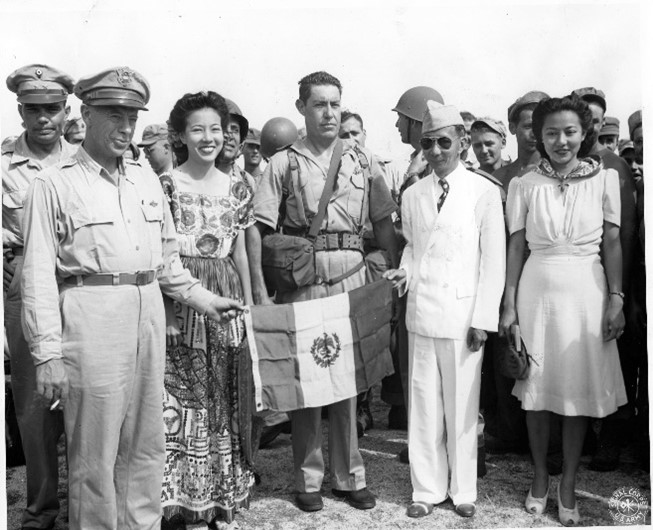
In this image, Squadron 201 is welcomed upon their arrival. L-R: Gen George Kenney, Conchita Carmelo, Col Cardenas, Honorary Mexican Consul to the Phils Don Alfredo Carmelo, and Leonor Carmelo
Photo courtesy of MacArthur Memorial Library and Archives
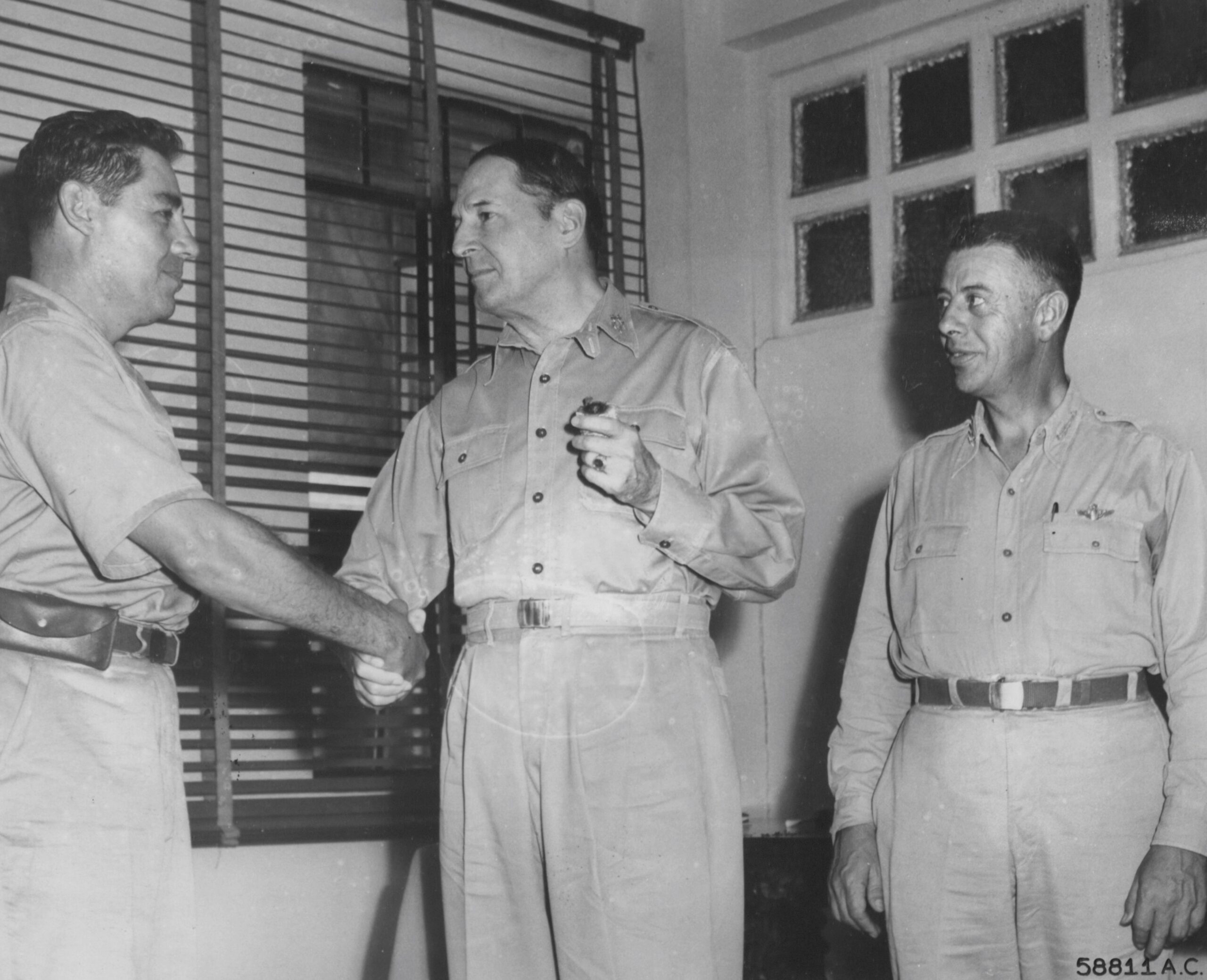
In this image, Colonel Antonio Cardenas was welcomed by General Douglas MacArthur upon arrival.
Photo courtesy of National Archives & Records Administration
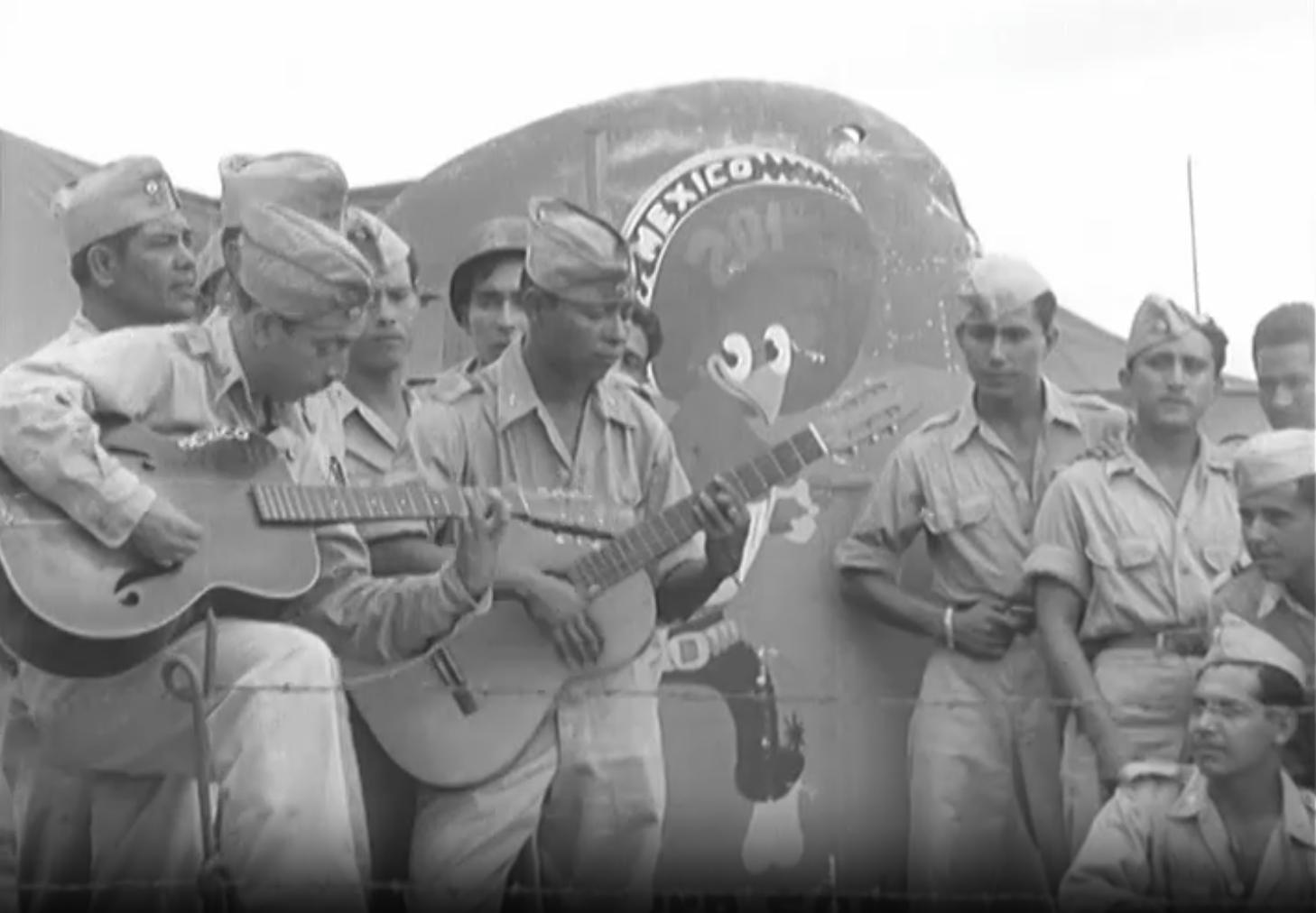
Members of the 201st Mexican Fighter Squadron celebrate the end of the war.
Photo courtesy of National Archives & Records Administration
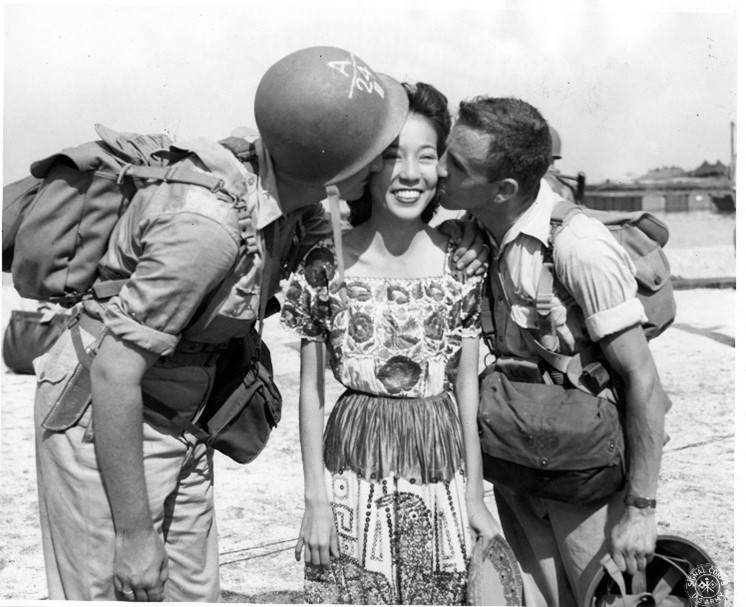
In this image, Miss Conchita Carmelo, daughter of the Honorary Mexican Consul to the Philippines is kissed by Lt Jose Espinosa and Capt. Pablo Rivas.
Photo courtesy of MacArthur Memorial Library and Archives
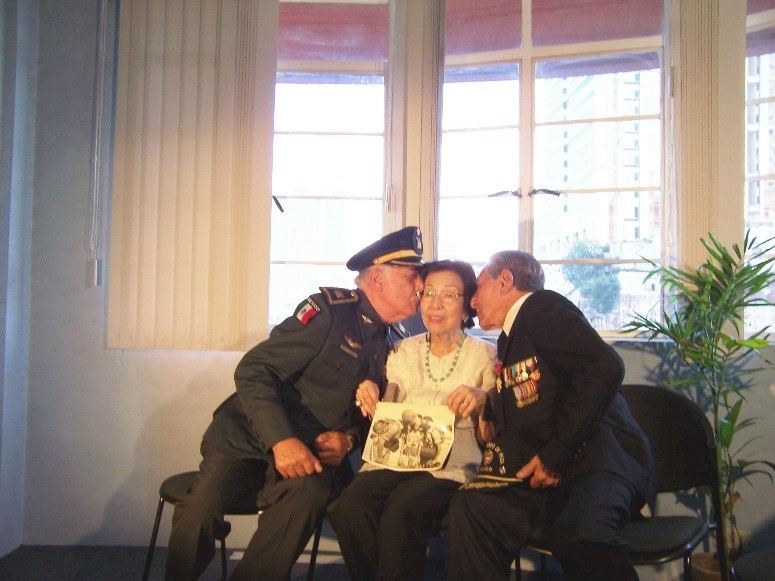
In this image, you see a reunion in Manila with Senora Conchita 60 years after the original photo above.
Photo courtesy of Sig Unander

In this image, the Aztec eagles are in front of their P-47s on Porac Strip, Clark Field, Luzon.
Photo courtesy of National Archives & Records Administration
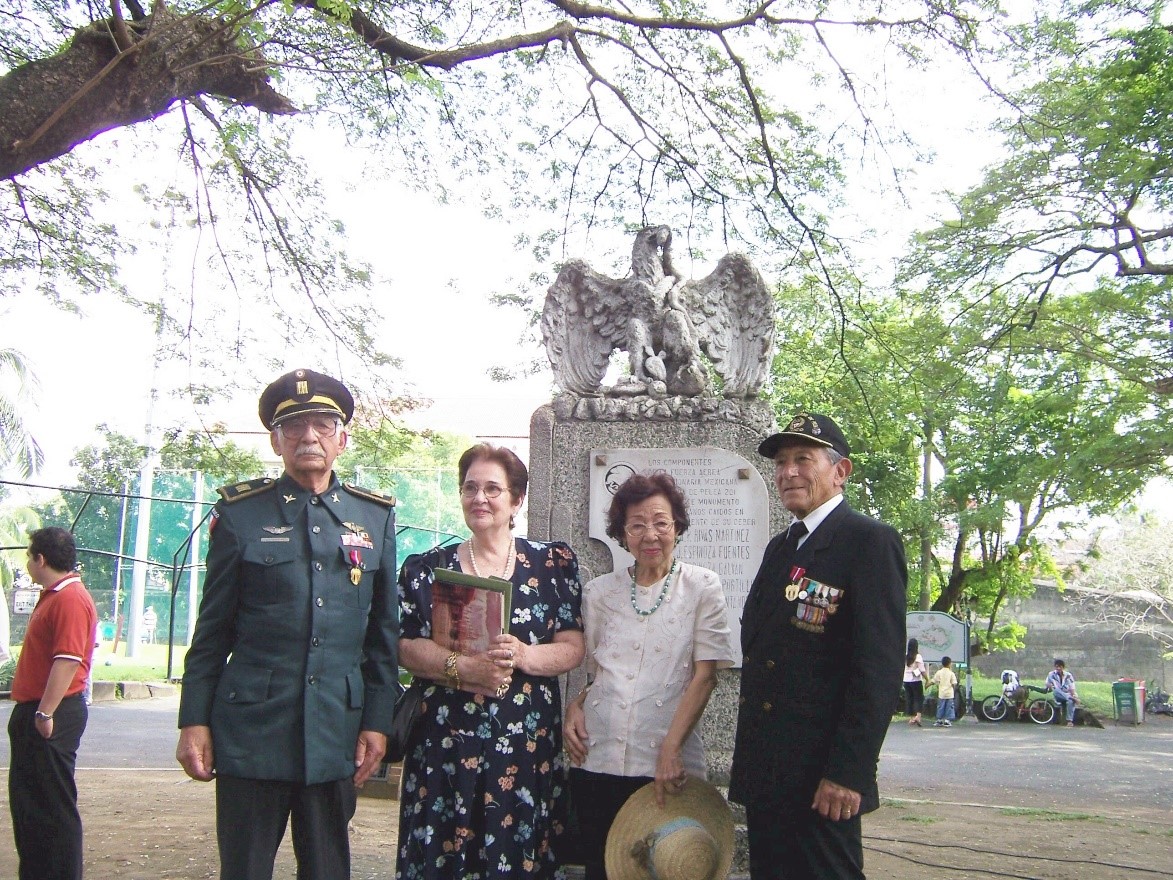
In this image Veterans of Squadron 201 visit the Philippines in 2004.
Photo courtesy of Sig Unander

In this image, Sgt Manuel Alcantar, who received an honorable discharge from the US Army to join the 201st Mexican Fighter Squadron, stands beside the squadron mascot “Pancho Pistalas” painted on the tail of a wrecked Japanese bomber.
Photo courtesy of National Archives & Records Administration
Gliders in WWII: Only a Lunatic Would Go There
by Nathan Huegen, CAF VP of Education
Published 8.16.24
In 1943, glider pilot George F. Brennan walked into a bar in Big Lake, Minnesota. He spotted three women sitting in a booth and asked them to dance. They asked if he was from “that glider school in Monticello.” He said yes, proudly mentioning that he was a pilot. Without hesitating, one of the women replied, “What do you have to be…a lunatic to go there?” It turned out that Brennan had flown his plane right over the three women paddling their canoe just days before. He flew past so low, that the women jumped from their canoe and into the lake.
Aside from bravado, there were other reasons that one could consider a glider pilot to be a “lunatic.” The Waco Glider, the most produced American glider, was made from wood, steel tubing, and fabric. It was unarmed and had no protection. Towed into the sky by a bomber or cargo plane, the glider entered a freefall the moment it was released. “You didn’t soar. You cut loose, you came down,” Brennan remembers. The speed during a tow was about 125 mph. The speed after release was just over 70 mph until the inevitable crash landing.
Weight and balance were critical to safe glider operations. On most drops, the pilot had between one and two minutes to find a landing spot before the crash. With minimal controls and gauges, any misplaced weight could force the glider off course. The wheels would often break apart on the landing, and the glider would skid to a stop. Unsecured cargo could be deadly to those inside. The gliders earned the nickname “flying coffins.”
The Waco was 48 feet long and had a wingspan of 84 feet. It could carry twice its weight. It had room to transport thirteen men along with the pilot and copilot. Alternatively, it could carry a jeep, a 75 mm howitzer, or a 105 mm antitank gun. The Waco could also carry ammunition and other equipment to aid paratroopers operating inland from invasion beaches.
The British developed a larger glider. At 67 feet long, the Horsa could carry up to 30 men or two jeeps. Its construction was mostly wood to conserve metal for other war needs. The Horsa also had large air-actuated flaps that could control the speed of descent. The Horsa’s pneumatic brakes, theoretically, would aid in stopping once on the ground. To control both the flaps and brakes, an air tank was positioned behind the pilot. Rapid construction and limited experience with gliders often resulted in ill-fitting parts or leaky air tanks.
By the time of the Normandy invasion, the U.S. Army procured both Waco and Horsa gliders for airborne operations. Over 800 gliders landed in Normandy during Operation Overlord, including a Horsa piloted by George F. Brennan. Brennan flew into Normandy in the afternoon with a load of ammunition. The Germans could see his glider in the daylight and fired once it reached the coast. When Brennan was over the landing zone, he realized his air tank was damaged and would have brakes on the ground. He scanned the countryside and found a long field between the system of hedgerows. He managed to put the glider down and then took cover in a ditch. Brennan spent the rest of his time in Normandy as an infantry soldier before he was sent to Italy to prepare for the invasion of southern France.
After a largely uneventful landing in Provence in August 1944, Brennan returned to England to prepare for Operation Market Garden, an airborne-led invasion of the southern Netherlands. This time, his glider encountered heavy flak and poor visibility. They cut the tow rope early and landed over 30 miles from their intended landing. After evading some Germans, Brennan and another man from his glider sought refuge on a farm. Despite severe wounds from the landing and a firefight, Brennan managed to evade the Germans, even being transported by a Dutch farmer on a cart full of manure. He was smuggled into a hospital where his wounds were treated. The nurses and medics were not sure he would survive.
Brennan held on until the British liberated the town and the hospital; Brennan returned to the United States. He married the woman from Minnesota who asked if he was a lunatic for joining the glider school in Monticello.
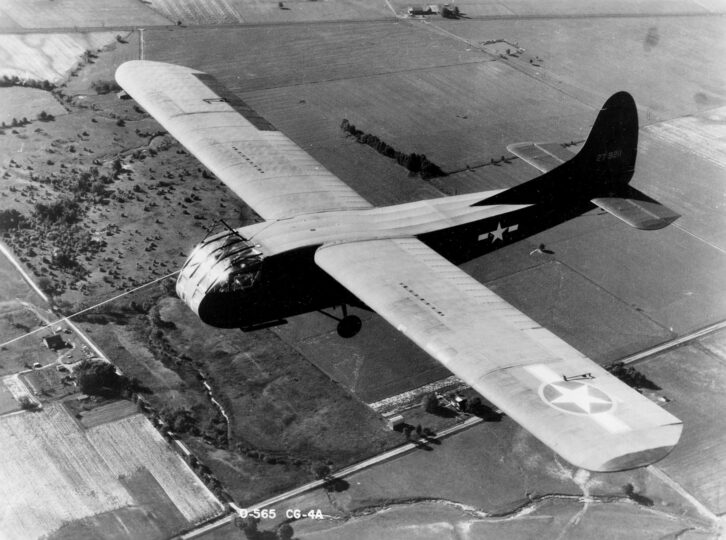
This is a photo of a U.S. Army Air Force Waco CG-4A-WO Glider. Photo courtesy of the National Museum of the U.S. Air Force.
The Need to Go: Toilets and Relief Facilities in WWII Aircraft
by Nathan Huegen, CAF VP of Education
Published 7.16.24
World War II was an exercise in logistics. For the United States, the War was the largest logistics experiment in the country’s history. With troops at sea, on every type of terrain, and in every climate, planning was required down to the smallest detail. Aviation as a major tool of war was a new concept, and many details had to be considered and reworked “on the fly.” This includes provisions for toilets and other relief facilities on board. By most accounts, the options to relieve oneself were not the greatest, so another focus was on minimizing the “need to go.”
Long-range fighter airplanes often had a relief tube, a funnel located near the seat connected to a tube that ejected the urine into the air. Albert Abraham, a P-51 pilot stationed in India, flew some incredibly long missions, some approaching 8 hours roundtrip from his base to targets inside Thailand and back. After the long missions, he recalled that the ground crew would have to lift him from the airplane after he became numb from sitting in one place for so long. He describes using the relief tube as an “interesting” endeavor. The P-51D “didn’t have much of a relief tube…You’d have to put out a few drops, then hold them back, and go a few more.”
On bomber aircraft, the crew could use a relief tube located in the bomb bay. On the B-17, the relief ejection area was located near the ball turret, which resulted in several harrowing moments for the turret gunner. B-17 navigator Donald Bertholf remembers his turret gunner thinking he had been hit when frozen urine crashed into the plexiglass on a mission over Germany. Sometimes, the liquid would splash on the turret and then freeze in place, hindering visibility.
Bomber aircraft could also have a chemical toilet behind the waist gunners. It was out in the open, but the area near the toilet did have a coat hook and a space for toilet paper. At high altitudes, anyone needing to use the toilet had to carry a portable oxygen bottle with them. Any individual who used the toilet was also responsible for cleaning it. Chemicals in the toilet were supposed to treat the smell, and they featured liners that were supposed to hold the contents for disposal. B-29 radar operator Mason Fitch remembers hitting an updraft on a mission over Japan and hearing the crew of another airplane in his formation talking about the toilet spilling its contents across the floor.
A way to manage the need to go to the bathroom was by planning the airmen’s diet. Anything that could cause excess bloating or gas was removed from their preflight meals. For example, airmen ate real eggs rather than the powdered variety since it was believed they would cause less gastrointestinal distress. Reminders to troops stationed throughout the Pacific cautioned against the local water sources and required the men only to use the treated water provided. Diuretics such as coffee became problematic, but the tension of the flight and the adrenaline of combat led to a lot of sweating. Many airmen discussed a lack of need to use the relief tube on the missions. Others resorted to using a bottle or thermos instead of the relief tube or chemical toilet.
Today’s lavatories on commercial airplanes can be small and cramped, but they have several features unavailable on World War II aircraft, including privacy and a way to flush. The contents of modern aircraft are held in a tank and not ejected toward the gunner in the ball turret. Modern passengers do not have to carry the portable oxygen bottle with them to the lavatory.
In the photos below, you can see the existing relief tube and evacuation point on the Commemorative Air Force's C-45 Bucket of Bolts.
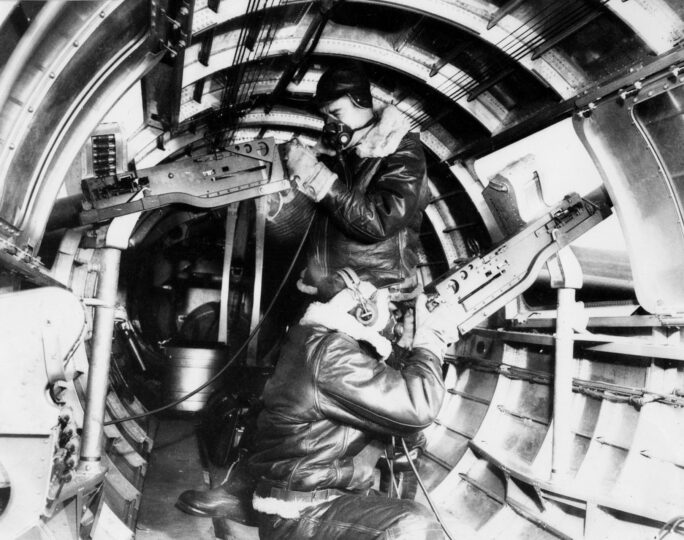
This image shows the bucket-shaped toilet positioned near the waist gunners in the B-17 Flying Fortress.
Image courtesy of the National Museum of the United States Air Force
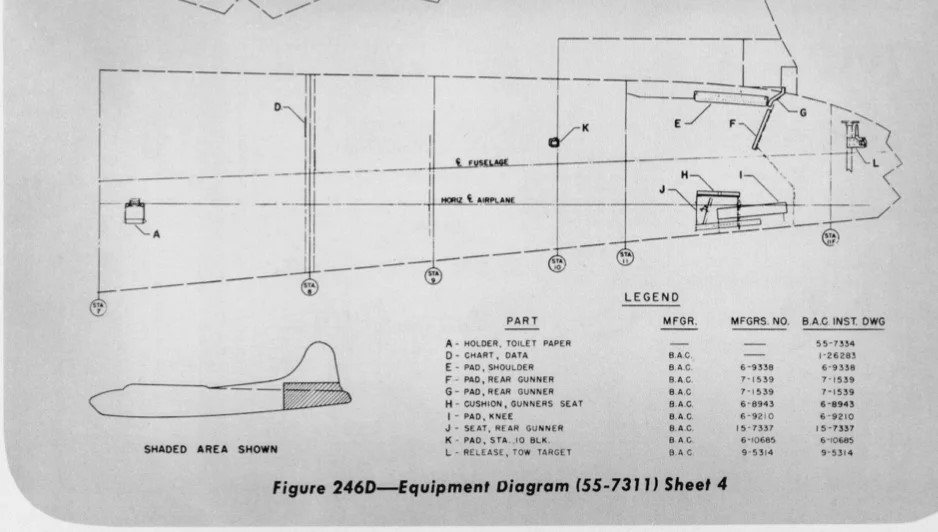
This image shows a diagram of the tail section of a B-17F showing the placement of the toilet paper holder.
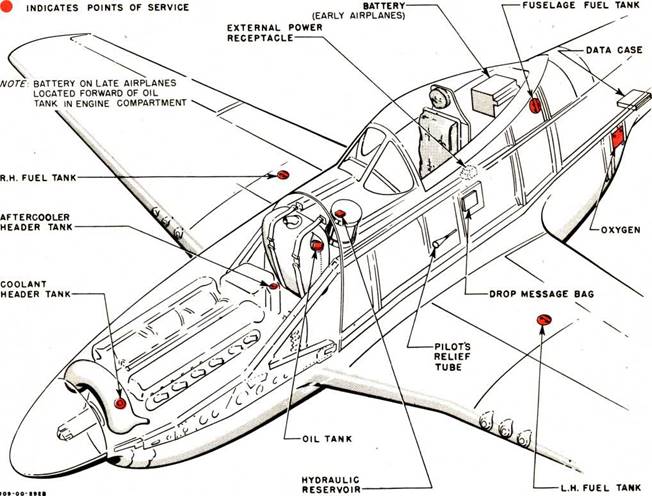
This image shows a diagram of a P-51 Mustang showing the location of the Pilot’s Relief Tube.
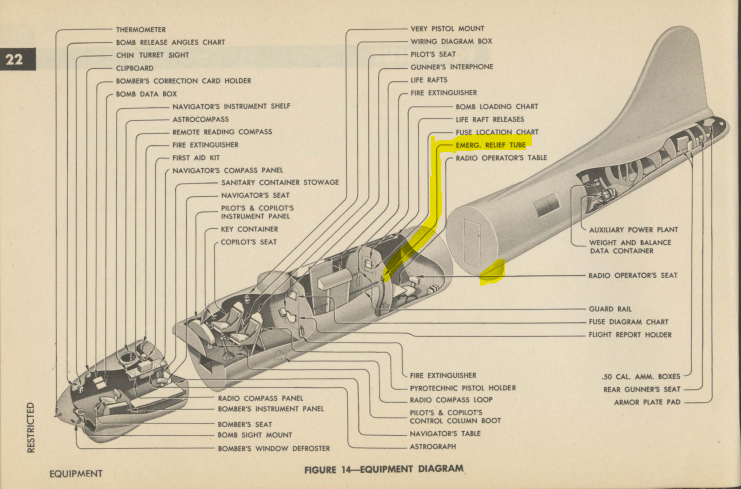
In this image, you can see the location of the Emergency Relief Tube in a B-17. Note the location of the tube relative to the ball turret.
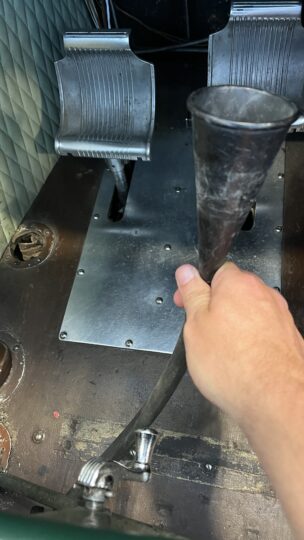
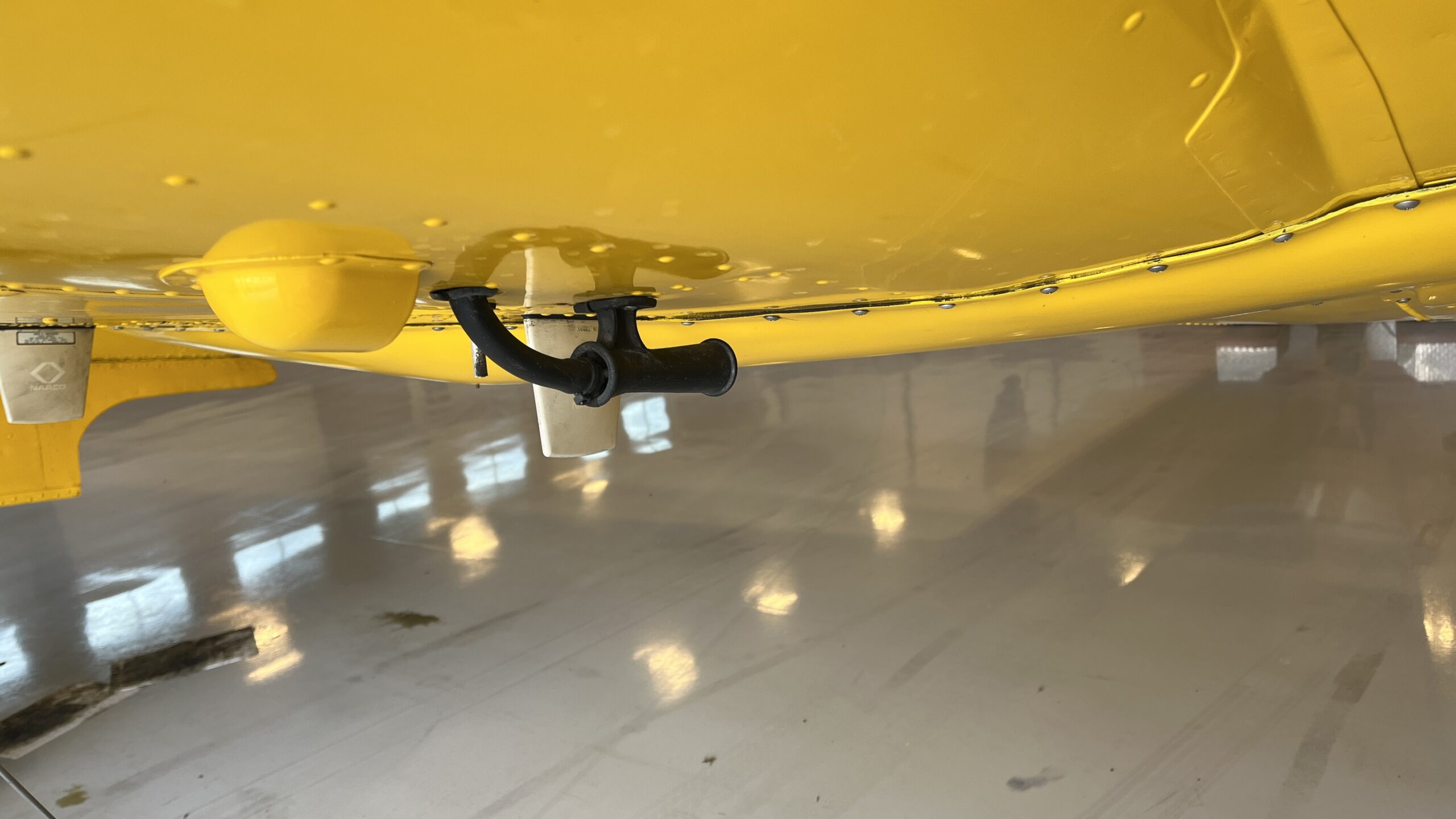
Ice Cream on the Frontlines: Sweet Treats of World War II
by Nathan Huegen, CAF VP of Education
Published 6.14.24
In every theater of the conflict—If there were Americans, there was ice cream
During World War II, ice cream served as an instant morale boost wherever it was found, and the military invested a great deal of time and money into procuring, creating, and distributing the sweet treat. A gathering with ice cream infused the event with optimism and led to smiles all around. For the service members, locating ice cream had much to do with geographic location, branch of service, duties, and a little luck.
The U.S. Navy had regular access to ice cream, at least on the larger ships. Some cargo ships even had sailors dedicated to operating ice cream machines that could churn out 5 gallons per batch and around 15 gallons per day. Melvin Munch, a sailor on the USS Rankin (AKA-103), described attending “ice cream school” while en route from Okinawa to Saipan toward the end of the War. After a few hours of training, he was awarded a diploma declaring him an official ice cream maker. He kept that diploma for the rest of his life.
Although tempting, the Navy kept only some ice cream for themselves. The ships would bring it to shore, and officers would even try to get it delivered to the front lines. The Navy purchased a concrete barge for $1 million and converted it into a floating ice cream factory to ship in large quantities. The barge, dedicated solely to ice cream, could churn out 10 gallons in just seven minutes. The barge’s appearance proved very popular throughout the Pacific, relieving soldiers and Marines growing tired of their “alphabet rations.”
One location that ships could not reach was China. The Japanese controlled the coast and all Chinese ports; therefore, supplying the interior took a lot of work. Arriving by air over the Himalayas, each piece of cargo was precious. Even then, ice cream made its way to the American lines. In Kunming, one state-of-the-art ice cream machine—the only one in the country—supplied enough ice cream to the 14th Air Force to offer each man a few scoops once every ten days.
At times, the American production of ice cream seemed extravagant to the local population. In 1942, the British government temporarily banned ice cream from American forces. Their rationale was that the British soldiers did not have ice cream, and children throughout the country went without it. The British Food Ministry said the ban would “free men for service, release refrigerating equipment, and save paper.” The ban was unpopular, and ice cream soon returned to the airfields and training bases.
In the meantime, American airmen were experimenting with making ice cream inside their bombers. Mixing the ingredients in a large can and hanging it in the rear gunner’s compartment, the crew had a nicely frozen and shaken treat at the end of a mission. Early attempts saw the airmen place the cans too close to the engines, where the heat resulted in a slushy product. The aircraft's rear hit the perfect temperature for a consistently frozen product. The process was repeated worldwide in various bombers, cargo, and transport airplanes.
As the War drew to a close, access to ice cream improved. The rationing of milk, eggs, and other essential ingredients was less severe. Enterprising locals in Italy, the Philippines, and Okinawa found they could earn money selling ice cream to the remaining Americans. Children deprived of almost all sweet treats often begged for a few bites. Still, for nearly every American, no amount of foreign ice cream could compare to that first scoop on the streets on any Main Street in the USA.
Photos from the National Archives and Records Administration

In this image is the lone ice cream machine in Kunming, China. This machine ensured each member of the 14th Air Force could have ice cream every ten days.
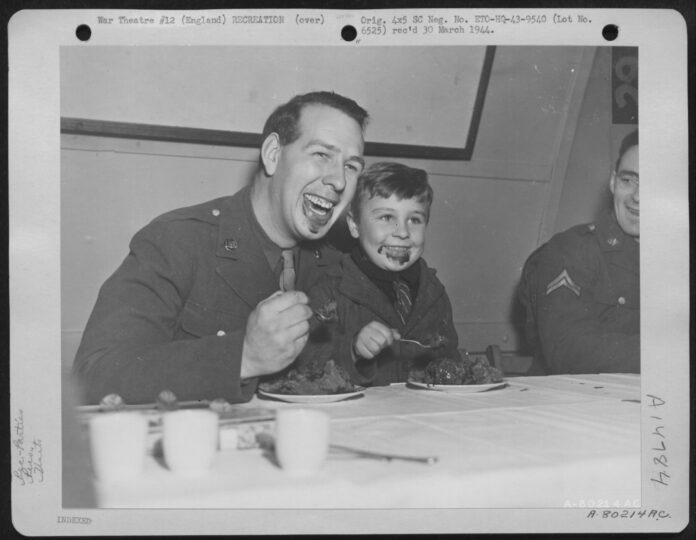
In this image, American airmen host a Christmas party for the sons and daughters of British soldiers in December 1943.
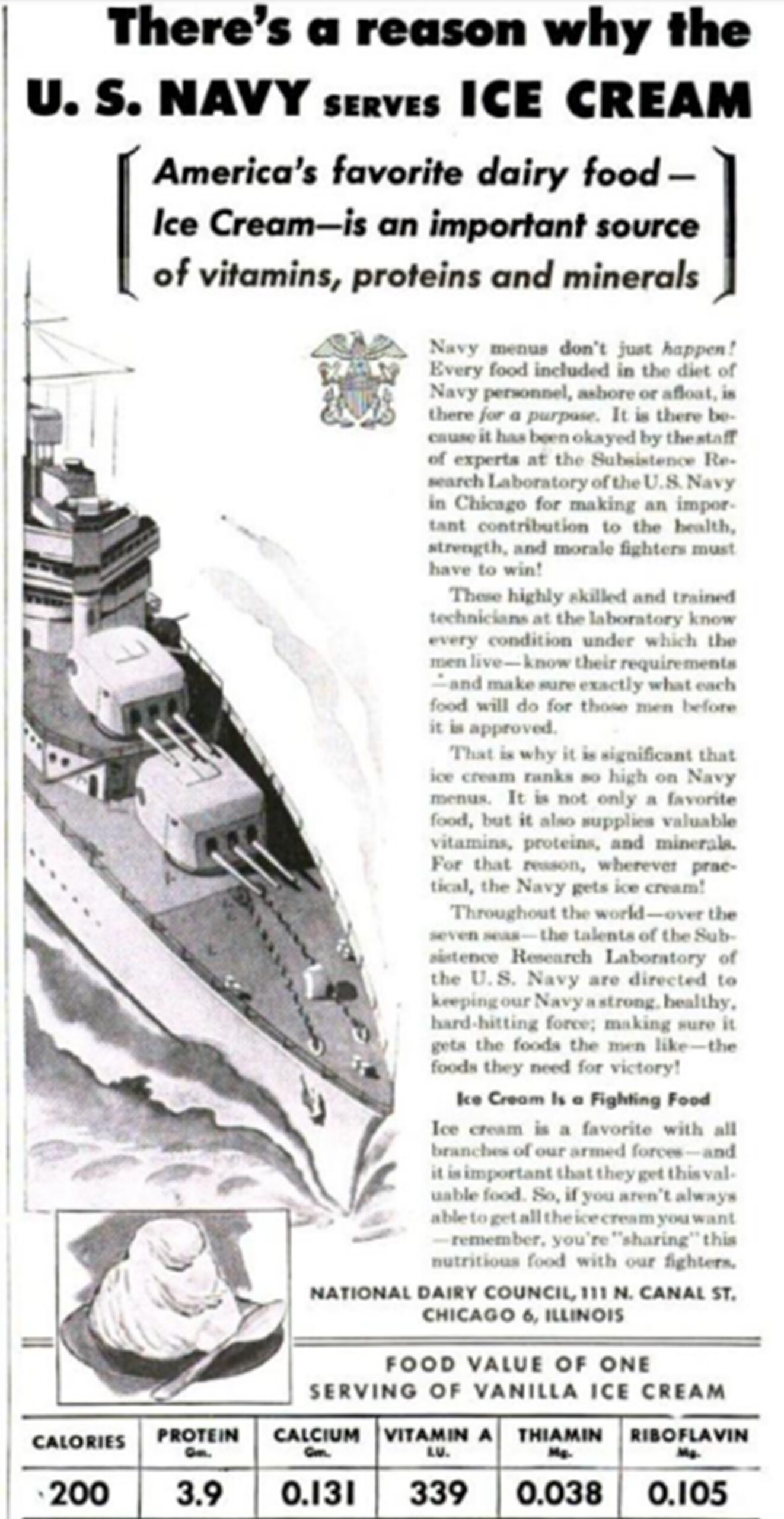
This is a clipping from the National Dairy Council Advertisement in the March 1944 edition of Hygeia Magazine – a publication of the American Medical Association.
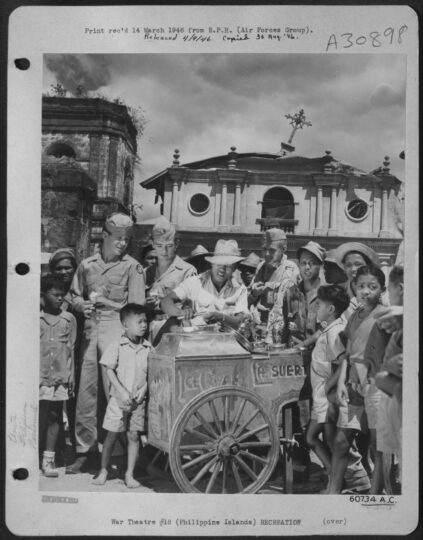
In the heat of the tropics - Ice cream was even sweeter. In this image, ice cream is dished out in Mindoro, Philippines.
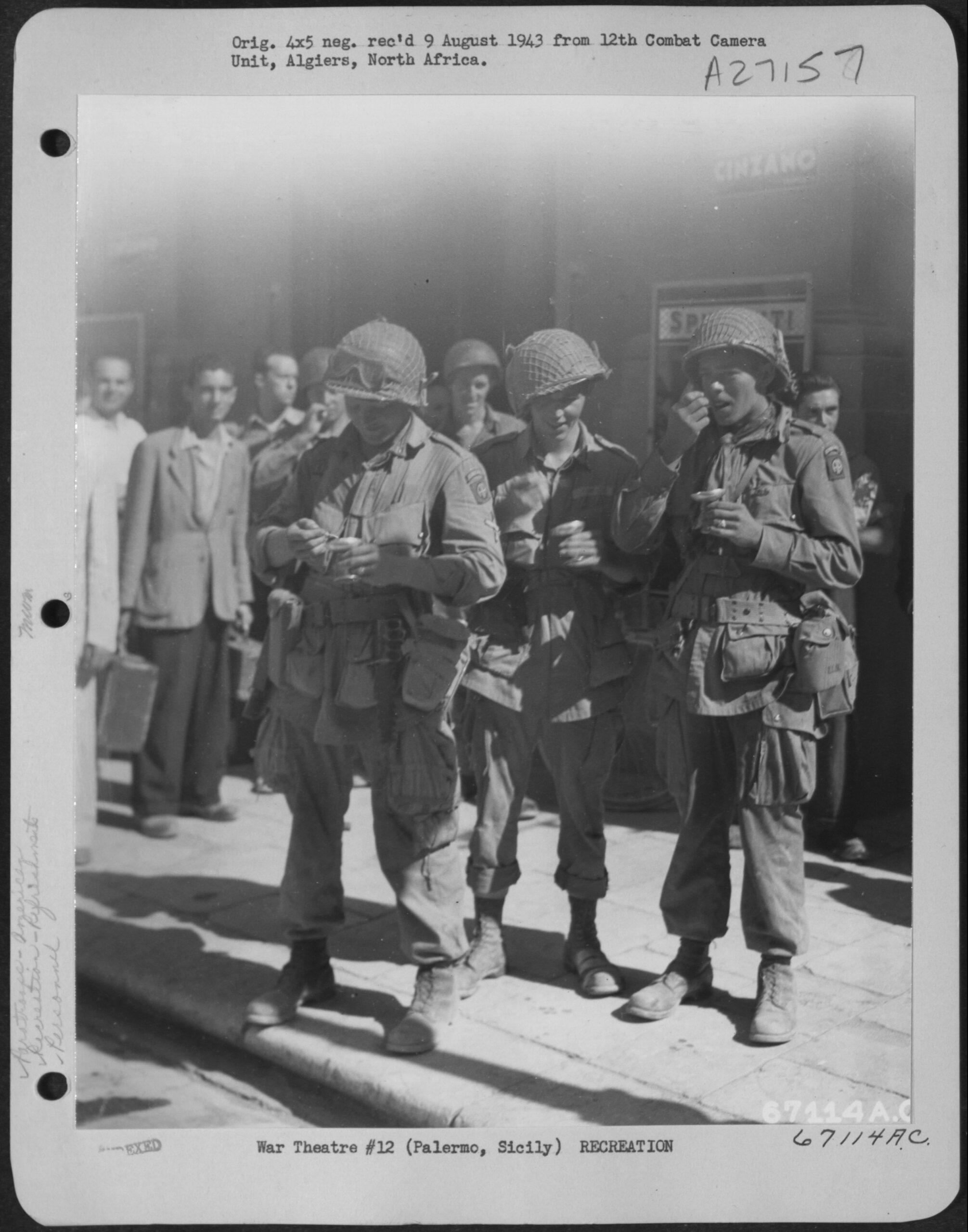
In this image, Paratroopers with the 82nd Airborne pause for ice cream in Palermo, Sicily.
Recovering American Soldiers crowd the bar waiting for ice cream at a hospital in Paris.
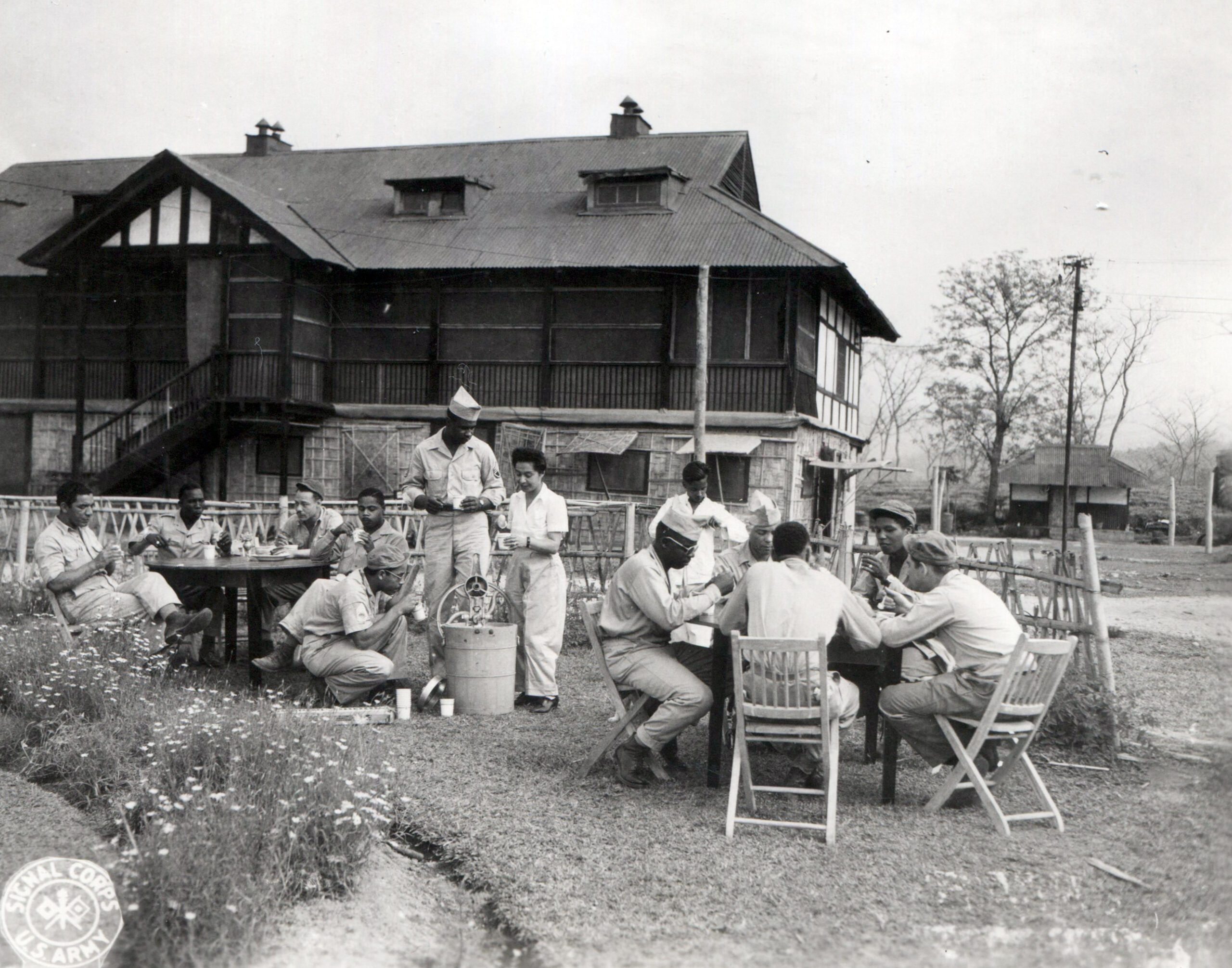
In this image, Black soldiers take a break from service in India for an ice cream treat.
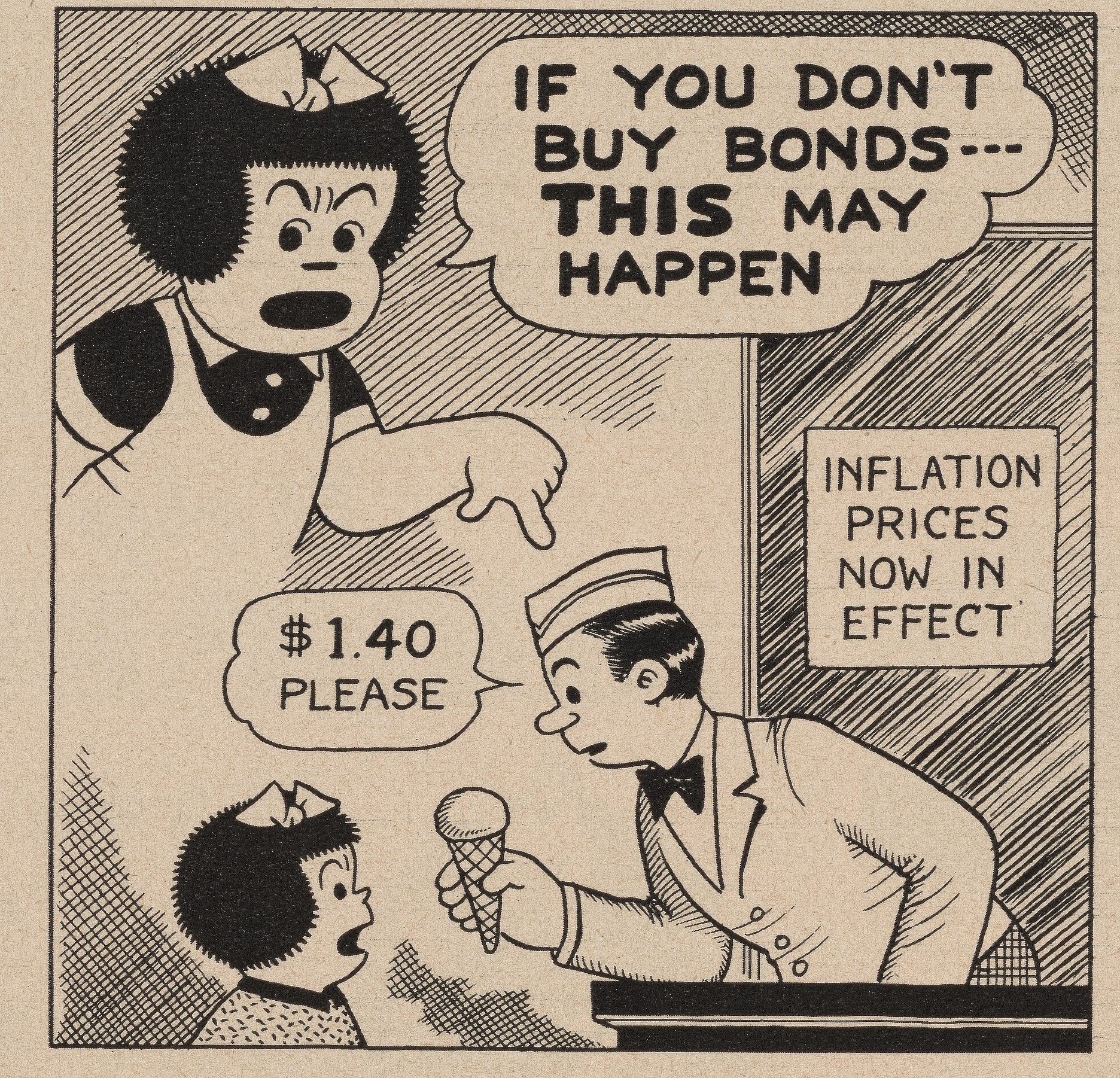
Ice cream prices were used as motivation to buy war bonds. This image was included with a poster urging students to buy war bonds to do their part to support the war and to keep inflation at bay.
Heroism and Honor in the Pacific Theater
by Nathan Huegen, CAF VP of Education
Published 5.15.24
World War II disrupted and transformed societies throughout Asia and the Pacific. The brutality of the war devastated families and destroyed entire cities, nations, and cultures. Through the devastation, stories of survival and heroism emerged from the wreckage.
Josefa Llanes Escoda, Aiding Prisoners of War
The United States accessioned the Philippines after victory over Spain in the Spanish-American War in 1898. Josefa Llanes Escoda was born this same year, and she experienced many of the imported American customs in the Philippines. After graduating from the Philippine Normal School in Manila, she joined the Philippine Chapter of the Red Cross. She then left the Philippines to attend Columbia University, earning a master’s Degree in Sociology in 1925. Her time in the United States introduced her to the suffragette movement, and she brought those organizing principles to the Philippines. Although the Philippines was subject to the United States, the country was moving toward independence, which began in 1946.
Escoda returned to the Philippines in the late 1930s. As she fought for women’s suffrage and established the Girl Scouts of the Philippines, officials in Manila were monitoring developments elsewhere in Asia. The Japanese war machine was on the march through China, and newspapers around the world documented the brutality of the Japanese Army. US negotiators demanded that Japan relinquish their gains in China and pursue a peace process. Japan refused the demands and unleashed attacks on Chinese civilians. Military commanders in the Philippines drew up contingency plans in the event of a Japanese attack.
On December 8, 1942, Japanese planes bombed bases in the Philippines as a landing force prepared for an all-out attack. General Douglas MacArthur declared Manila an open city, and his forces moved to defensive positions in Bataan and Corregidor, where they held out until May 1942. The surrenders of Bataan in April and Corregidor in May formed the largest surrender of American forces in history. This resulted in a brutal death march and a humanitarian crisis in the prison camps.
Escoda and her husband Antonio worked to provide medicine, food, and clothing to the prison camps. They would also relay messages to and from the camps. The Japanese grew suspicious of the Escodas’ actions and arrested the couple. Josefa Llanes Escoda was last seen alive in January 1945. Josefa Llanes Escoda is renowned for her civic activities and World War II duties in the Philippines. From 1991-2022, Escoda was featured on the Philippines 1,000 Peso bill along with fellow World War II heroes Vicente Lim and Jose Abad Santos. The year 1998 was proclaimed as Josefa Llanes Escoda Centennial year by President Fidel Ramos.
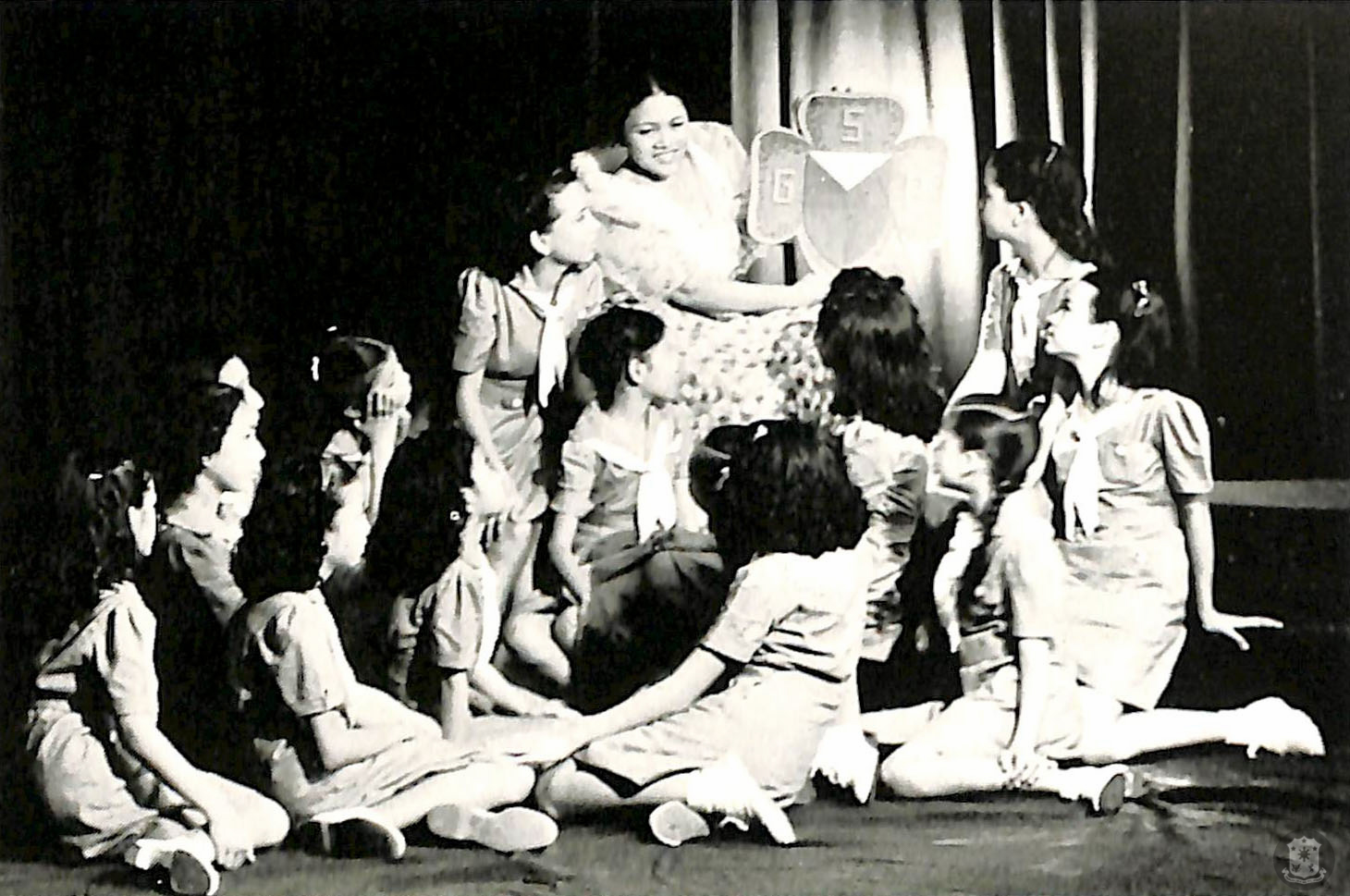
Josefa Llanes Escoda with a group of Girl Scouts. Escoda was the founder and first National Executive of the Girl Scouts in the Philippines.

Josefa Llannes Escoda appeared on the Philippines 1,000 Peso bill along with fellow WWII heroes Vicente Lim and Jose Abad Santos.
Jacob Vouza, A Scout for the Marines
Sir Jacob Vouza was born on the island of Guadalcanal around 1892 just as the British Solomon Islands Protectorate began to govern the islands. The British hoped to develop profitable coconut plantations on Guadalcanal, but they never established a large military presence. Few Europeans inhabited the islands with just a handful of plantation owners, businessmen, and missionaries living scattered among the islands. Providing security for the business interests fell to locals such as Vouza who began working for the Solomon Islands Protectorate Armed Constabulary 1916.
In 1942, the Japanese arrived in Guadalcanal mostly unopposed. Most of the initial Japanese soldiers were construction workers with orders to build an airstrip that, when completed, would put their bombers in range of the major cities on Australia’s east coast. The Allies countered the Japanese on August 7, 1942 as the 1st Marine Division landed on Guadalcanal in the first American offensive of World War II. Vouza, who had volunteered with the Coastwatchers, rescued a downed pilot during the opening days of the operation. Escorting the aviator to the American lines, Vouza first met American Marines.
Two weeks later, Vouza was scouting for Japanese outposts in the jungle when he was captured. A small American flag in his loincloth gave him away, and the Japanese tied him to a tree and tortured him, hoping to find information on the American forces. Vouza refused to cooperate with his captors, and he managed to chew through the ropes. Crawling through dense jungle to the American lines, Vouza warned the Marines that a force of several hundred Japanese were on their way to attack their position. Once recovered from his injuries, Vouza returned to action with the Marines.
For his service in World War II, Jacob Vouza received the Knight Commander of the Order of the British Empire along with the Silver Star and Legion of Merit from the United States. A statue of Vouza appears along the main road in the capital of the Solomon Islands, and his family continues to support remembrance ceremonies in Guadalcanal.
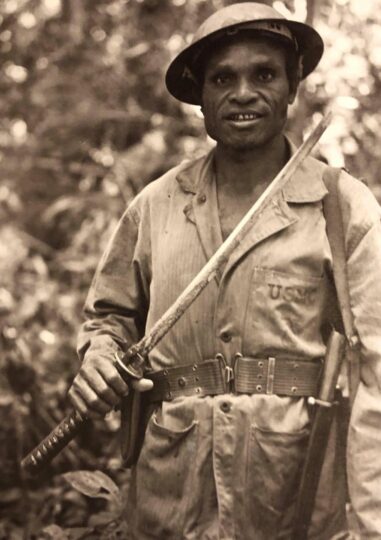
Jacob Vouza posing in his Marine uniform during the Battle of Guadalcanal.
Sefanaia Sukanaivalu, Recipient of the Victoria Cross
Sefanaia Sukanaivalu was born in Fiji in 1918, just a few generations after the British annexed the Kingdom of Fiji in 1874. Under the British, local rule in Fiji remained under the domain of chiefs, and Fiji raised its own military in both World War I and World War II. His name, Sukanaivalu, means “return from war.” His birth coincided with the return of his island chief from France during World War I. Sukanaivalu enlisted in the Fiji Infantry Regiment, which was placed under the command of the United States. The Fijian soldiers served throughout the Solomon Islands campaign from Guadalcanal to Bougainville.
On June 23, 1944, Sukanaivalu was on a patrol on the west coast of Bougainville when Japanese soldiers ambushed his unit. Sukanaivalu crawled forward to rescue some wounded men when the Japanese again attacked. Sukanaivalu rescued two men but was seriously wounded. Rescue attempts were made, but each attempt resulted in heavy Japanese fire. Rather than risk the lives of his fellow soldiers, Sukanaivalu rose up and exposed himself to the Japanese guns. Sukanaivalu was killed, but his patrol was able to retreat to a safe position.
Sukanaivalu is the only Fijian to receive the Victoria Cross, the highest military award in the British Honours System. A mural of him adorns the city hall in the capital city of Suva. His final resting place is at the Bita Paka Commonwealth Cemetery near Rabaul, but plans have been announced for the repatriation of his remains to Fiji.
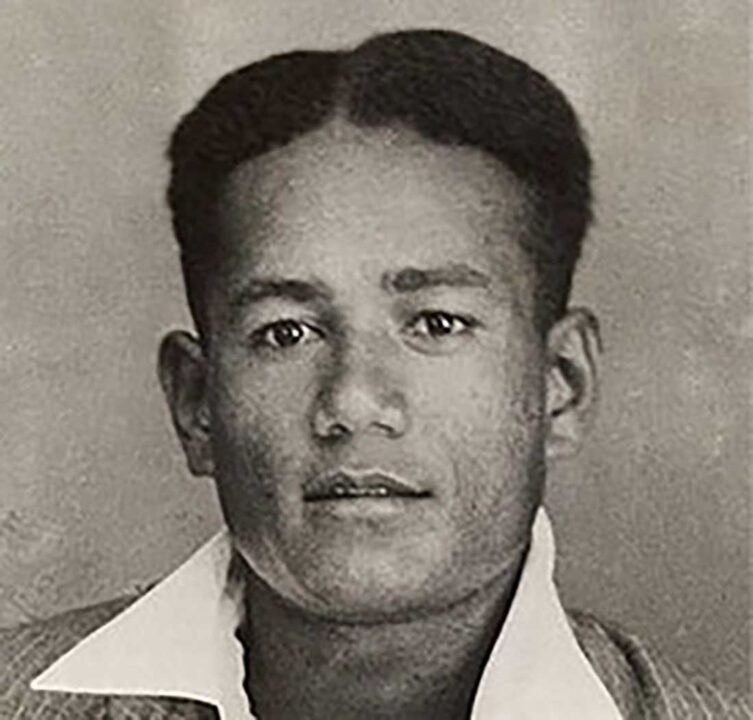
Sefanaia Sukanaivalu prior to enlistment
Kimiuo Aisek, Living with the Japanese
At the outbreak of the War, Kimiuo Aisek was a teenager in Truk Lagoon, now called Chuuk. Born during the time of the Japanese mandate over the islands that began in 1919, Aisek learned to speak Japanese and to become a good “child of the emperor.” He was usually quick to scale a coconut tree at the request of a thirsty Japanese official, and he found favor with a sailor named Uchida.
On February 17, 1944, the American attack on Truk, Operation Hailstone, began. Three carrier task groups launched over 500 aircraft in a massive operation to destroy the Japanese base. Aisek and his family took refuge in a cave before curiosity took over and he wandered outside to watch the bombing. He remembers watching the explosion of the Aikoku Maru, a ship he frequented when he would deliver cargo for the Japanese.
In 1945, the United States began repatriating the Japanese and administering the islands under a United Nations Mandate. Aisek found the Americans strange, but he slowly learned English and found work on the cargo ships operating between Truk and the Mariana Islands. He later lived in Hawaii to train in commercial fishing. By 1972, Aisek was working as a diver in the Department of Fisheries in Truk when a renewed attention to the Japanese shipwrecks brought “wreck-divers” to the lagoon.
Aisek found a new calling in assisting the divers with their tanks and in providing guidance on the islands. He was so skilled and personable that many of the divers asked when he would open his own dive shop. On November 13, 1973, Kimiuo Aisek opened Blue Lagoon Dive Shop, the first of its kind in Truk. Aisek personally escorted many divers to the wrecks in the Lagoon. The dive shop became wildly successful, purchasing the former Continental Hotel in 1998. Nearly every map and guidebook to the Japanese wrecks of Truk Lagoon can be traced to the efforts of Kimiuo Aisek.
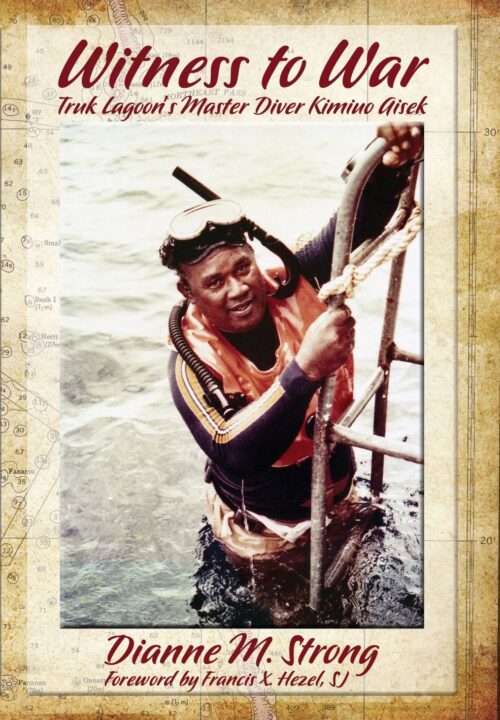
Kimiuo Aisek’s life story is told in a book by Dianne Strong
Beryl Owens Paschich: A WASP Pioneer
by Nathan Huegen, CAF VP of Education
Published 4.12.24
“Watch your air speed. Watch your air speed.” Beryl Owens’ assigned flight instructor on the AT-6 was fond of saying “watch your air speed,” but Owens did not know what to do with her air speed when she “watched it.” Frustrated, she went to her mentor, a civilian flight instructor who had taken her under his wing. She told him she had not figured out how to correct the air speed to the instructor’s liking and asked him what she should do. A short response came from her mentor. “Ask for a change of instructor.”
Owens received a new instructor, a short man who had to sit on four cushions inside the AT-6, and she finished her training. This experience summarizes Owens’ experience as a WASP. She was always progressing even if an obstacle came her way.
Owens began her journey as a pilot in San Antonio, TX when she was a volunteer with the Ground Observer Corps. She noticed a sign asking, “All women interested in flying or aviation come to a meeting of the Texas Wing of Women Flyers.” Owens joined the group she referred to as a “flying club” of “maybe 12 to 15” members. The group invited Jacqueline Cochran, the head of the Women Army Service Pilots (WASP) to speak. Owens was hooked. She worked to get her flight hours up to the standard and applied for entry.
Owens met her first obstacle with the application. Other women she knew had been accepted for training, but Owens had not heard from Cochran or anyone with the WASP. Fortunately, a friend she met in Washington, DC had become Cochran’s secretary. Owens wrote a letter asking, “what’s happened to my application?” Her friend searched, and found it buried on Cochran’s desk. She was accepted for training.
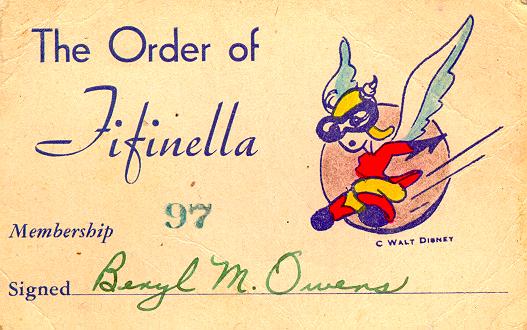
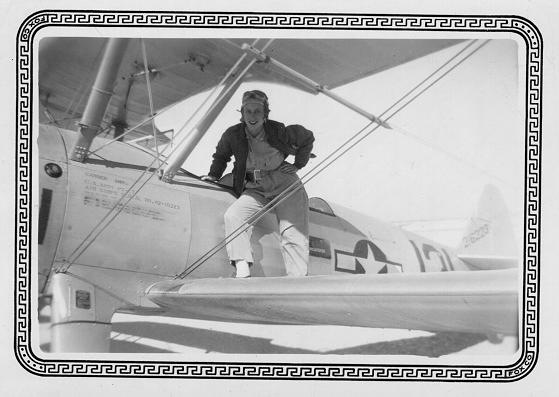
Upon arrival to the training field in Sweetwater, TX, Owens received her uniform— “mechanic’s overalls…the olive drab ones and they were like ten sizes too big.” The women jokingly referred to them as “zoot suits,” referencing the baggy suits that had been trendy among African American and Latino men. The “really swanky uniforms” would have to wait until graduation.
During her training, Owens flew the PT-19, Stearman, AT-6, and BT-13. She hoped to fly a B-26, but every time she got close, the assignment changed. She spent most of her time as a pilot at Majors Field in Greenville, TX. At the field, she would pilot BT-13s that had undergone repair. An observer would fly with her in the repaired aircraft. “They would take some tape and a piece of string about two feet long, maybe 18”, and tape these pieces of string all over the wings and the flying surfaces at maybe a foot apart…they would watch and if there were eddies when those strings went around they knew there was something wrong in that spot.”
After the WASP were disbanded on December 20, 1944, Owens applied for a job with the FAA. She continued in that position until she married a fellow FAA employee, Jack Paschich. She resigned due to the FAA’s anti-nepotism policies, noting that “he might be my supervisor and that would never do, but it’s not that I would ever be his supervisor.” Beryl Owens Paschich received her honorable discharge in 1979 after the WASP were officially named an active duty military unit in legislation signed in 1977.
Women in STEAM Infographic
An infographic for Women's History Month
by NAEC Education Team
Published 3.13.24
Click to download
Supplying the Air War at Wright Field
Elizabeth S. Stark Oral History
by Nathan Huegen, CAF VP of Education
Published 3.12.24
On Friday, March 13, 1942, twenty-two-year-old Elizabeth Stark received the surprise of her young life. Upon reporting to Wright Field in Dayton, Ohio, Stark found that she was eligible for a permanent civil service appointment. Her new clerical job at Wright Field was not simply for the duration of the war, it was a career. Aside from her new duties as a stenographer, filling out forms with carbon copies 15 deep, there was much for Stark to do. Finding a place to live, forming a social circle, and searching for the best places to eat were high on her list. A move to Dayton from her home in Bowling Green, Kentucky was anything but routine in 1942. Dayton, as the new air logistics hub, was booming. Wright Field employment soared from 3,700 in 1939 to a peak of over 50,000.
Wright Field and neighboring Patterson Field buzzed with activity round-the-clock. Workers entered and departed at all hours. Construction crews worked feverishly in expanding the base from 40 buildings to more than 300. From her post, Stark remembers that the construction was “chaos, because the building wasn’t completed, and we were operating on wartime, which meant we went to work in the dark most of the time.” To reach the building, she crossed “a large area with boards across it…underneath the board were mud and all sorts of trash. You didn’t dare fall off the board.” The workdays were long and frequent. Stark recalls, “we were required to work six days, eight hours a day at least. I think every other week we worked Sunday also.”
After a few weeks as a stenographer, Stark caught the eye of a civil engineer from Air Materiel Command, and she accepted a job as his assistant. She did most of his writing and reporting while also working on some of her own projects under his supervision. The work done by Stark and her colleagues was instrumental in the conduct of the air war. Supplying air crews was a new task, and procedures started with basic projections of troop movements. Initial forecasts for supplies were based on six-month forecasts of deployments, but the needs of the airmen and the supplies they received rarely synchronized.
Stark and her colleagues adjusted as the war progressed. As the air crews completed their missions and the mechanics kept the planes flying, the number of supplies needed per aircraft became clear. Materiel Command could anticipate the number of jacks, tools, and equipment to route with the new aircraft. As depots around the country became better organized, the flow of logistics improved. Her team felt like a well-oiled machine, and Stark developed a close bond with her colleagues that extended to leisure activities like a softball league.
When the war ended, Stark had mixed emotions. “I can remember that everybody had left on VJ Day, and I went home. You were supposed to out celebrating, I guess, but I had a funny, way-down feeling that maybe this was one of the greatest experiences of my life, and it was coming to an end. I’m sure there were a lot of other people in the service who had the same feeling because a lot of people came from nowhere and this was the first time they had been able to do something.”
Stark remained at the newly christened Wright-Patterson Air Force Base after the war, working in Curtis Lemay’s Strategic Air Command. She met Lemay several times and found him very “demanding” and that he “had a lot of ideas that I didn’t agree with.” After a few years of seeing more and more men with less qualifications come in with jobs above her, she asked if she would be
in the running for a promotion. She didn’t like the response, so she followed a previous supervisor to a new position in the Pentagon in 1954, and later took a job with a bank to help lead the shift to computerized banking.
Reflecting on her time at Wright-Patterson, Stark says that she “gained confidence in my ability to do something…Working there and being able to walk in and talk to a major general or lieutenant general and give presentations in front of them did something for my confidence. I took those skills to Washington, D.C. and eventually to the savings and loan.”
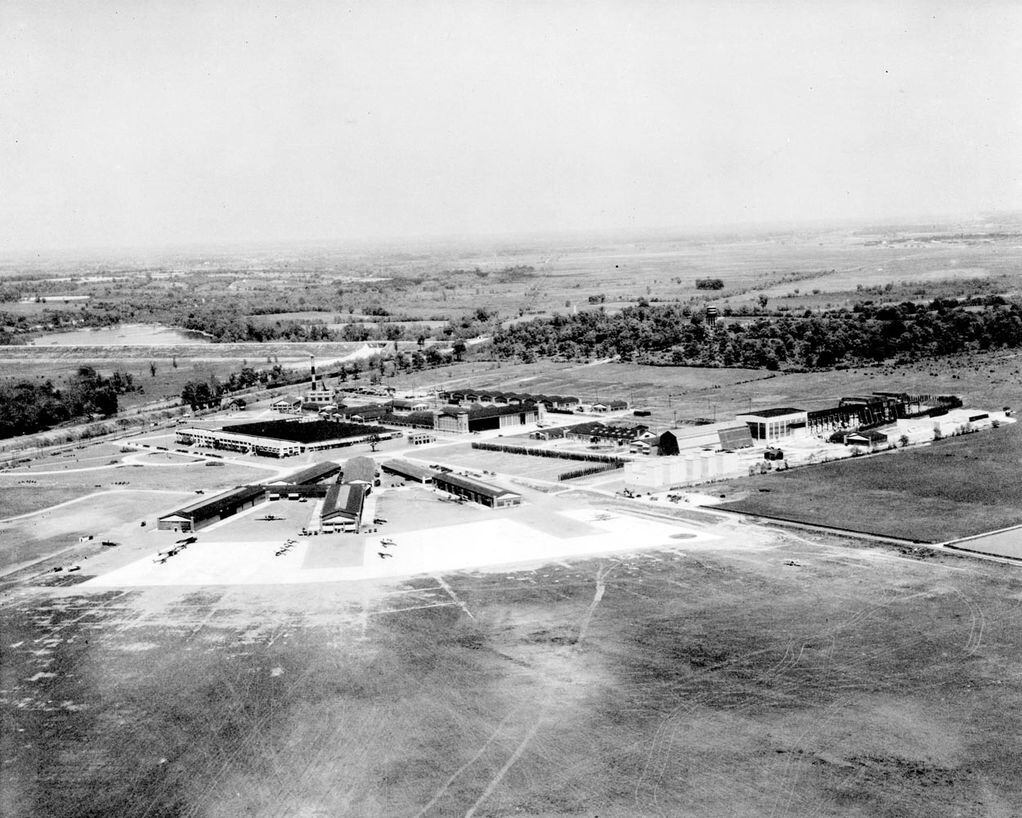
Wright Field in the 1930s before the massive expansion during World War II. Elizabeth Stark was one among the tens of thousands of civil workers employed at Wright Field during WWII. In 1948, Wright Field merged with neighboring Patterson Field to become Wright-Patterson Air Force Base.
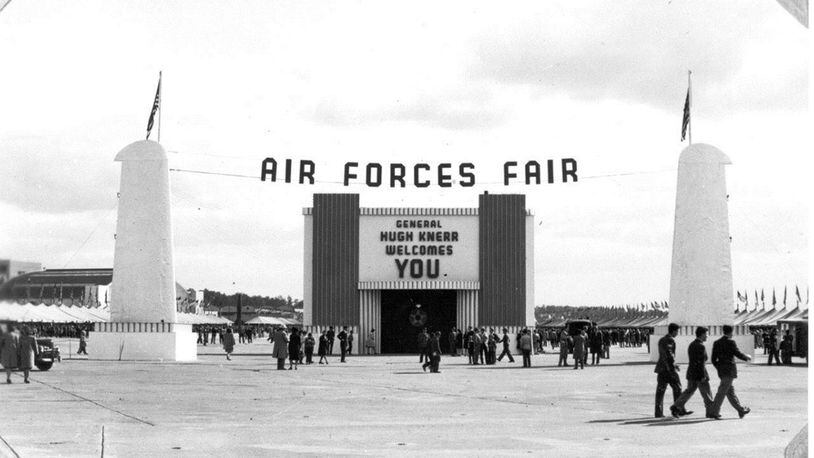
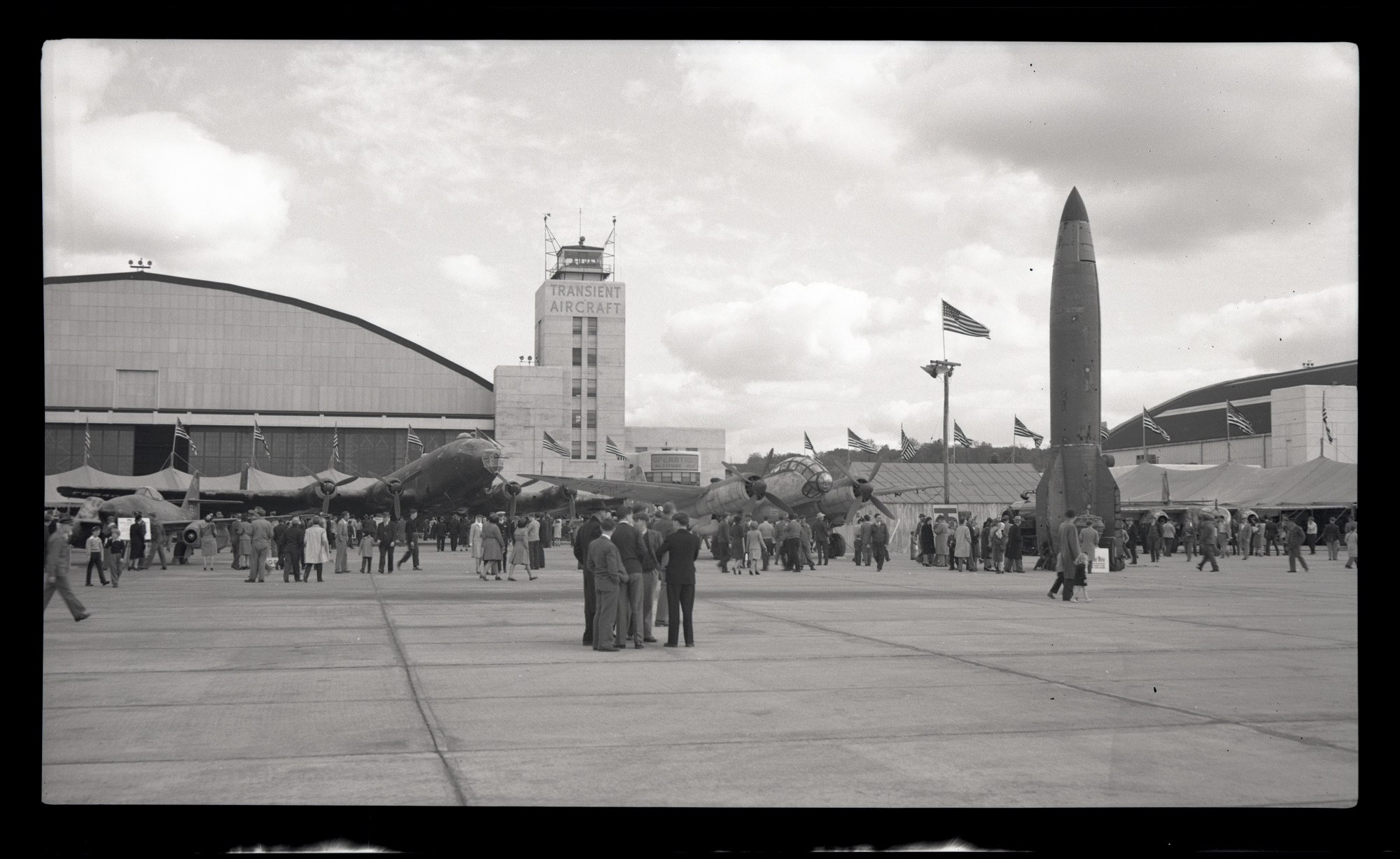
In October 1945, an Air Forces Fair was held at Wright Field. Attendees came to marvel at the fleet of American aircraft and curiosities like a captured German V-2 Rocket. Elizabeth Stark continued her employment at Wright-Patterson with Strategic Air Command.
Images courtesy of the National Archives and Records Administration
Master of the Air Part 1
Donald F. Bertholf Oral History
by Nathan Huegen, CAF VP of Education
Published 2.14.24
Masters of the Air, released last week on Apple TV+, highlights the experiences of the 100th Bomb Group. The 100th received the nickname, “The Bloody Hundredth” due to severe losses encountered during its early missions. The Oral History Project housed at the Henry B. Tippie National Aviation Education Center (NAEC) features stories from many of the crewman who served in the 8th Air Force. This month, we focus on Donald F Bertholf of Harlingen, TX who served as a navigator in the 100th, and his experience over three days during “Black Week” in October 1943.
On October 8, 1943, Bertholf’s string of missions began with a raid on shipyards near Bremen on the northern coast of Germany. The antiaircraft fire was thick. Bertholf recalls, “it’s just like you read, just like you read in the books, you know, or see in the movies or something’ and here we are, right in the middle of it. And we got through it…we got a whole bunch of hits that they had to fix.” On the success of the mission, Bertholf remarked “probably not” when asked if he hit the target. The flak was too great, and the altitude was too high.
The next day, Bertholf flew to Marienburg to bomb an aircraft factory. This would be the farthest mission undertaken to date, and they would bomb from 12,000 feet rather than the 25,000 at Bremen. We “creamed ‘em,” Bertholf remembers. Photos showed direct hits throughout the target area. Leadership from Bomber Command all the way up to Winston Churchill sent their congratulations to the units involved.
On October 10, in an ambitious undertaking, the 100th was ordered out for the third day in a row. The target was Munster. Of the 18 aircraft assigned from the 100th, one did not take off, four—including Bertholf’s—returned due to mechanical issues, and twelve were lost over Munster. Only one plane returned from Munster. A B-17 nicknamed Royal Flush piloted by Robert “Rosie” Rosenthal. From the 100th Bomb Group alone, Eighty-two men were captured and 37 killed. Losses at that rate would quickly become unsustainable for the 8th Air Force.
When Bertholf first arrived in England in September 1943, he heard a rumor about the 100th. “All they do is fly submarine patrols.” After Black Week, Bertholf saw the man who uttered the rumor. Not holding back, Bertholf said, “you S.O.B! Where is this submarine patrol business?”
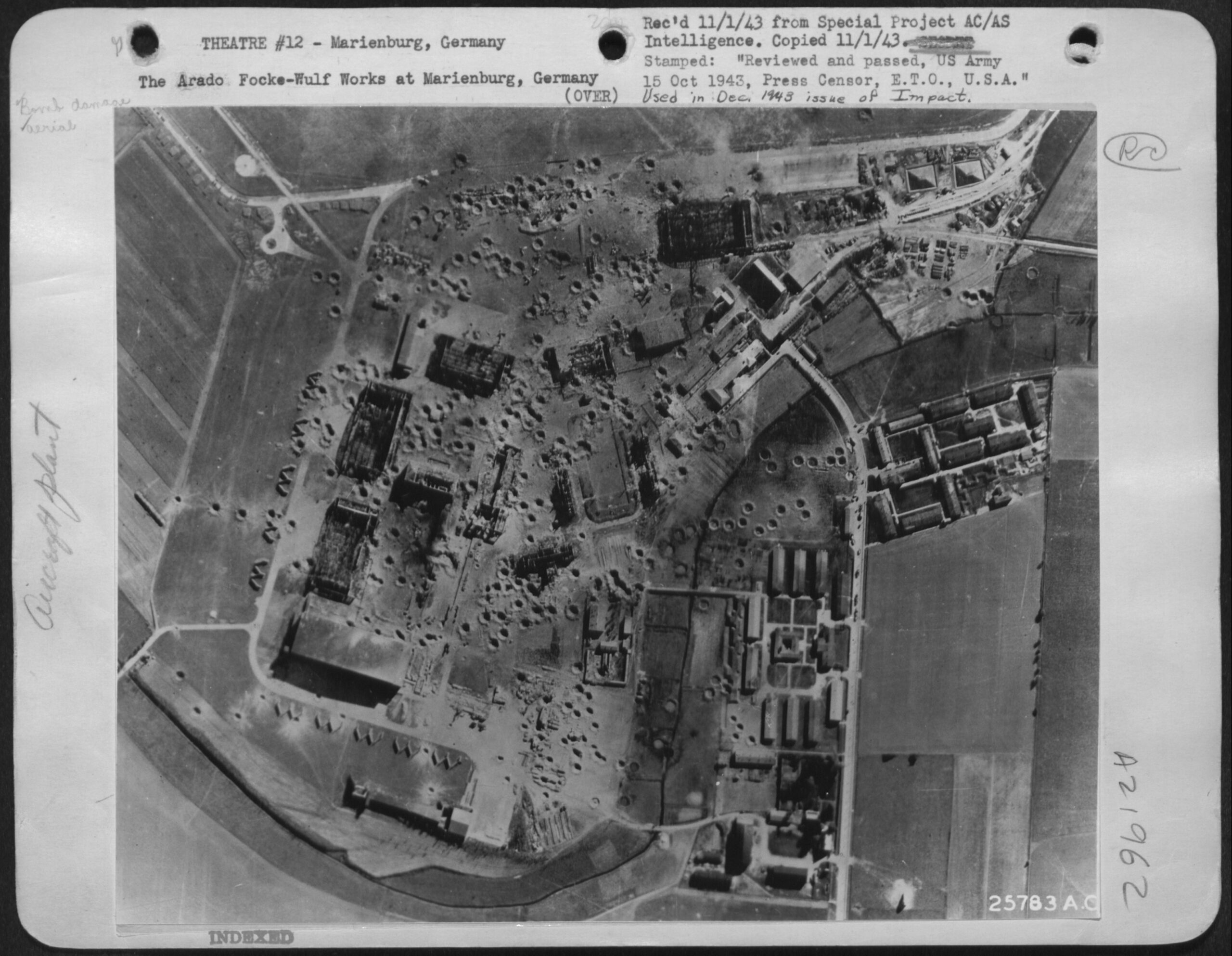
A reconnaissance photo showing the aftermath of the Marienburg Raid. Only one building escaped a direct hit. Lt. General Ira Eaker called Marienburg “a perfect job” and “a day to remember in the air war.”
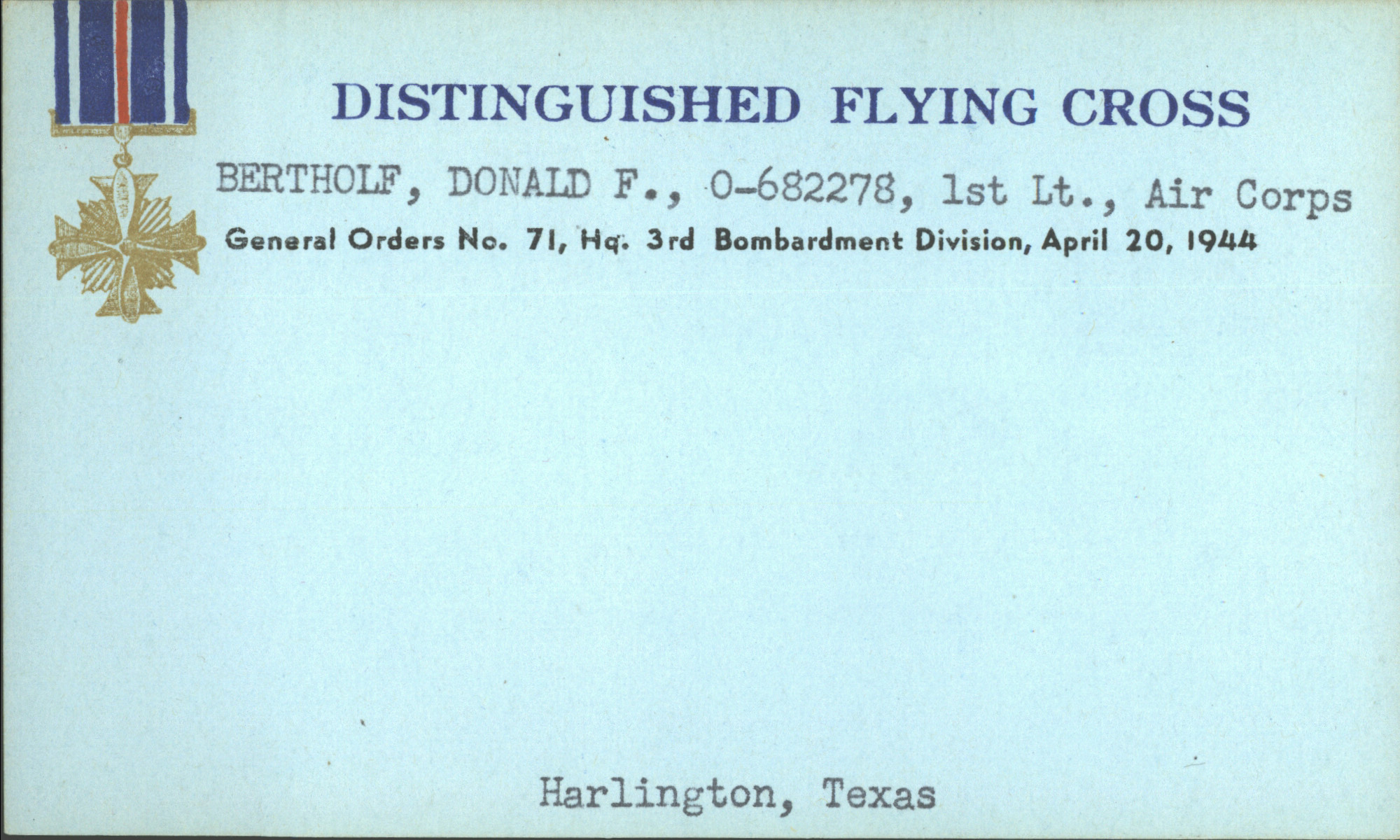
There are little to no photos available of Bertholf but there is this card noting his award of the Distinguished Flying Cross that misspelled Harlingen, TX as Harlington, TX.


